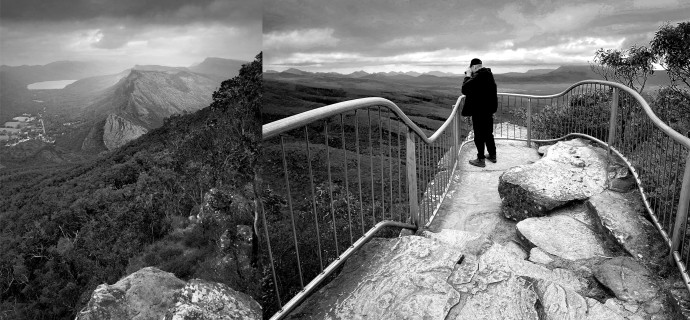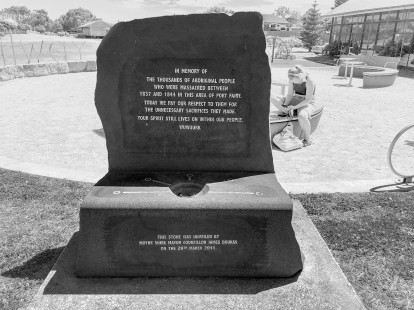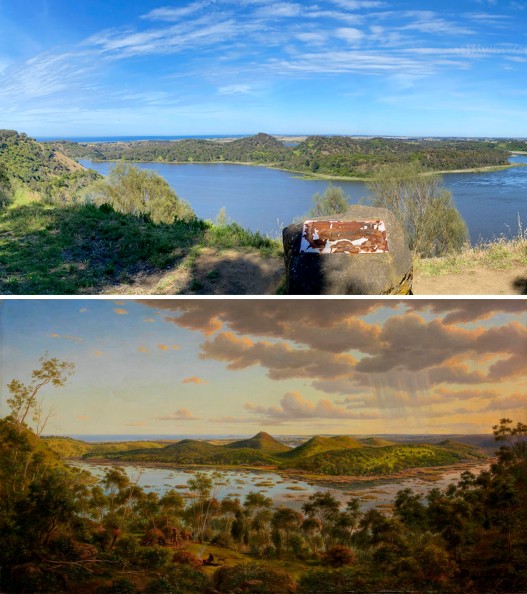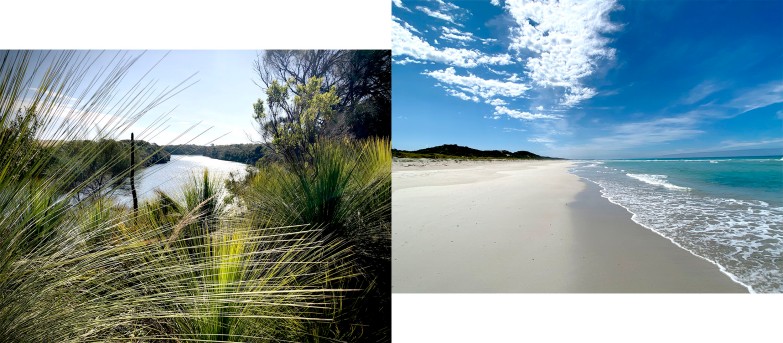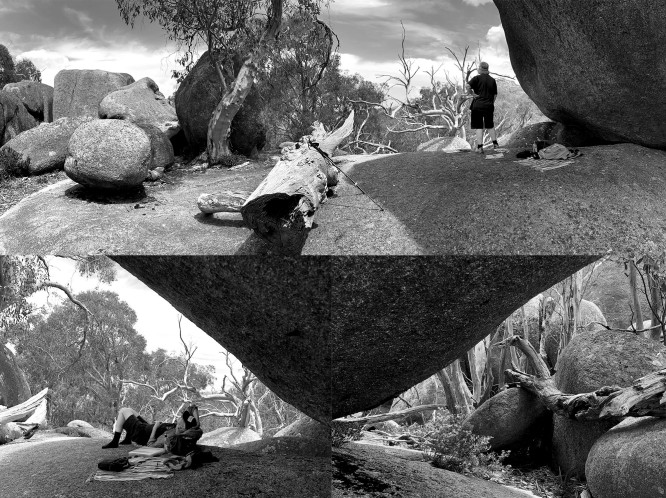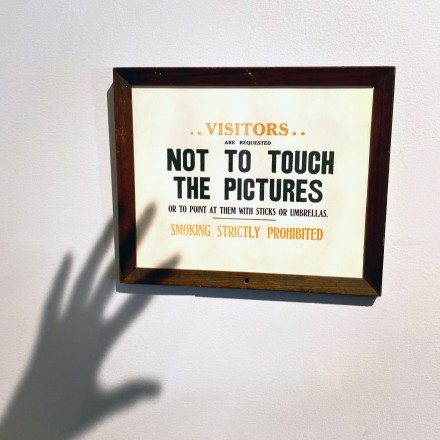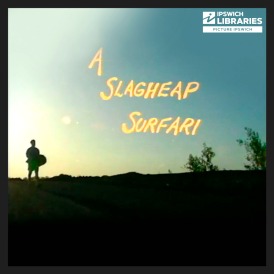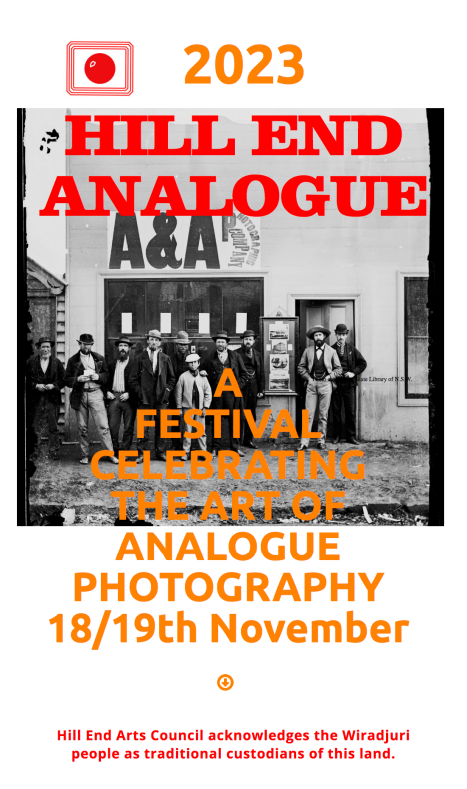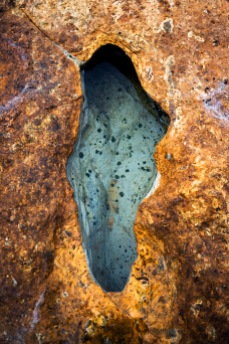Archive for the ‘Regional arts’ Category
JULIE MILLOWICK’s ‘Surrounding’– Intrinsically Local
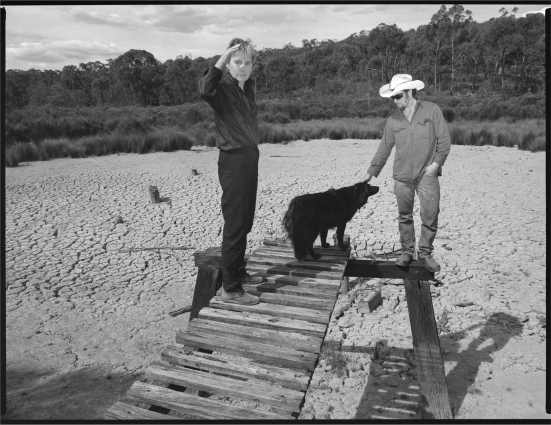
Continuing Drought El Nino year – Julie Millowick with son Christian McArdle at Crocodile Reservoir PHOTO: Courtesy of the artist
.
SURROUNDING
The beauty of Central Victoria’s landscape in tumult and recovery
.
An exhibition by Julie Millowick at Castlemaine Art Museum
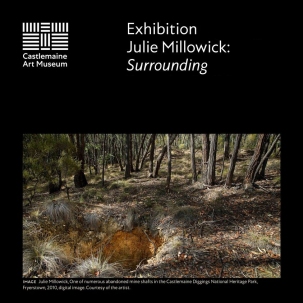
CAM – Surrounding Julie Millowick
.
“Photography is my life; it is the very core of my being”
Julie Millowick
Surrounding is an exhibition by Julie Millowick surveying her lived experience over 36 years in Fryerstown, Victoria. Over time this celebrated documentary and commercial photographer, driven by a curious and creative mind, has created a photographic archive both cataloguing her visual inquiry and providing a chronicle of her life within this place. Millowick’s work is multifaceted where the poetic and psychological is interconnected with an almost scientific aesthetic thus sharing deep insights into the land that has both nourished and challenged her.
The curator, Jenny Long, has written a sensitive and informative essay for the book Surrounding that accompanies the exhibition. Long discusses Millowick’s process and conceptual thinking along with observations to provide background and framework for the viewer to consider this extensive project. Along with the book there is promotional material and didactics that proposes the exhibition will ‘show us the devastating effects of mining, drought, flood and invasive plants, but also remind us of the interconnectedness that links all parts of this ecosystem including its human occupants.’ And that there is a, ‘capacity for renewal … that offers a spark of hope for the future.’
.
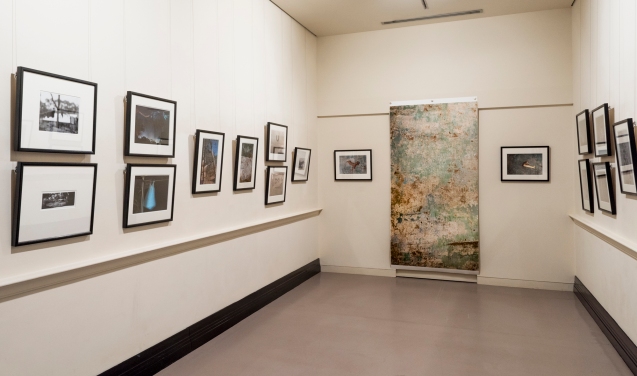
Surrounding House and domestic installation PHOTO: Supplied by the artist
.
In the first gallery space, the ‘house and domestic’ body of work is presented as twenty-three individual framed works including an 1870s photograph an original owner, Mrs King, standing outside the home. In this work Millowick’s subject matter includes botanical still-life works, images of the detritus of past inhabitants unearthed in the house grounds and there is also a large print of a section of a house wall interior etched with the marks of habitation and the patina of age. Images of washing drying on the clothesline refer to the domestic space of the past and present habitation of this home. Far from being prosaic records of domesticity, the photographs of the washing have an ethereal perhaps even ghostly appearance.
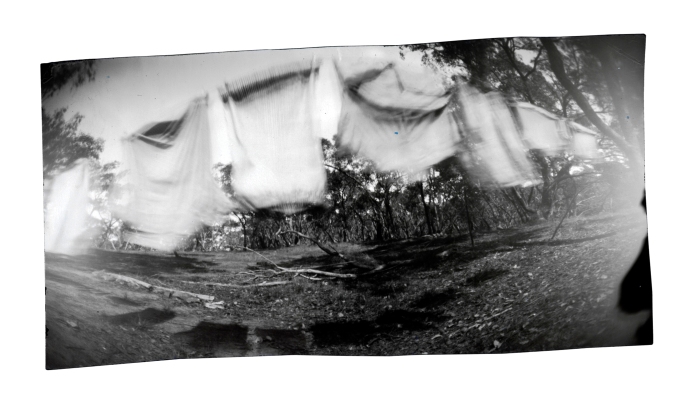
Washing in Horse Paddock pinhole image 1996 PHOTO: Courtesy of the artist
.
There is also a kind of haunting in the walls and surrounds of the house, which continues through the shadowy and dramatically lit scenes of this exhibition. The appearance of a selectively illuminated tree branch or the enchanted presence of Millowick’s horse Goldie, imbues the place with a mythical spirit that beckons the viewer to follow into the mysterious dark forest.
.
.
Contrasted with a sense of wonder and fairy tale mystery, Millowick’s work is also deeply grounded in the reality of place, which is as sharp and unadorned as the land itself. In the larger exhibition space, there are groupings of unframed images that explore both topographical and psychological aspects of specific spaces and themes including mine sites, the Castlemaine Diggings National Heritage Park, ecological thinning, the Crocodile Reservoir Drought and horse paddock. A constant subject for Millowick is her son Christian whose activities are documented in many of these themes. images within the groups are placed together to form clues and evidences that suggest larger narratives. It is also interesting to consider the installations as visual representations of the conversation between artist and curator piecing together the rich collection of work and the resonance or dissonance between images and concepts.
.
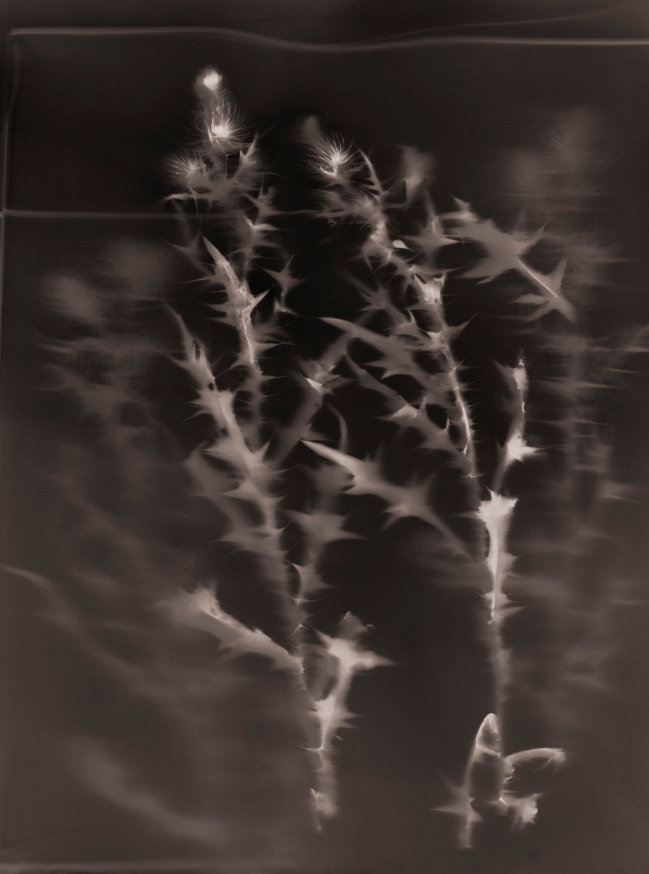
Invasive Thistles 2002 Lumen print by Julie Millowick
.
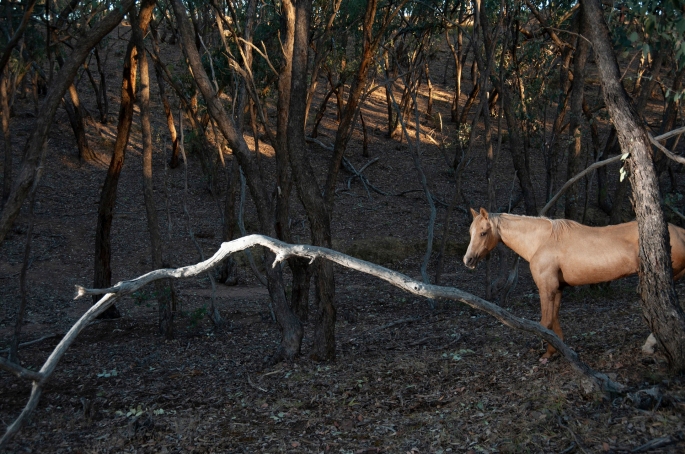
Goldie, 34 year old horse 2009 PHOTO: Julie Millowick
.
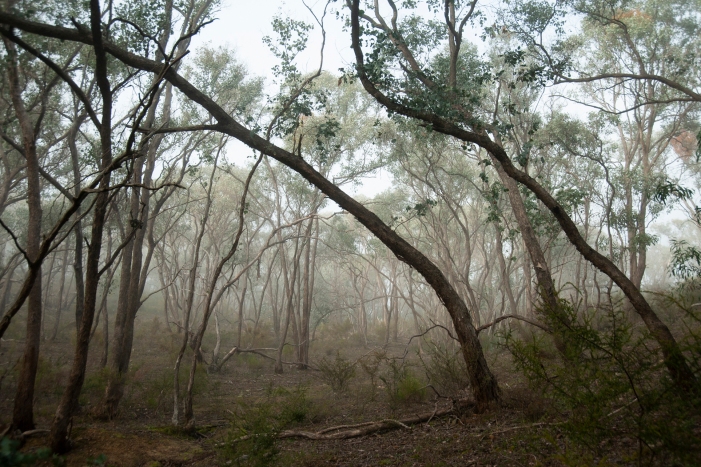
Horse Paddock Post Goldrush Uniform Regrowth PHOTO: Julie Millowick
.
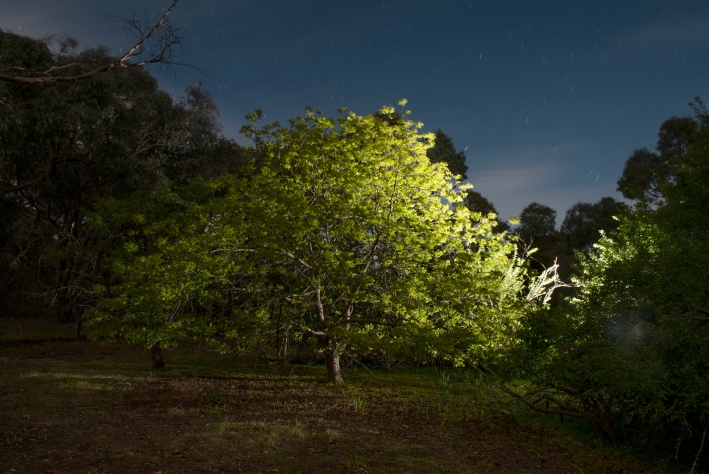
Fryerstown, Isolation, Lockdown, Orchard, Chinese Pistachiola Tree, last moments before midnight on 21 October, and first moFryerstown, Isolation, Lockdown, Orchard, Chinese Pistachiola Tree, last moments before midnight on 21 October, and first moments on 22 October PHOTO: Julie Millowick
.
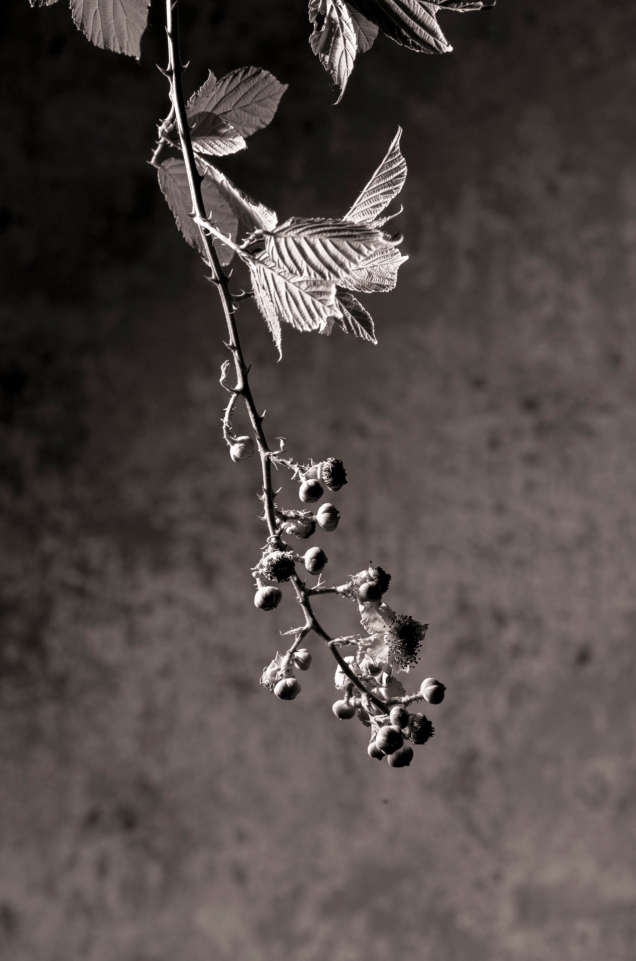
Original Cottage Wall with introduced Invasive Blackberry 2023 PHOTO: Julie Millowick
.

Fryers Diggings, Sluicing, Heron’s Reef 2023 PHOTO: Julie Millowick
.

Crocodile Reservoir 2006 PHOTO: Julie Millowick
.
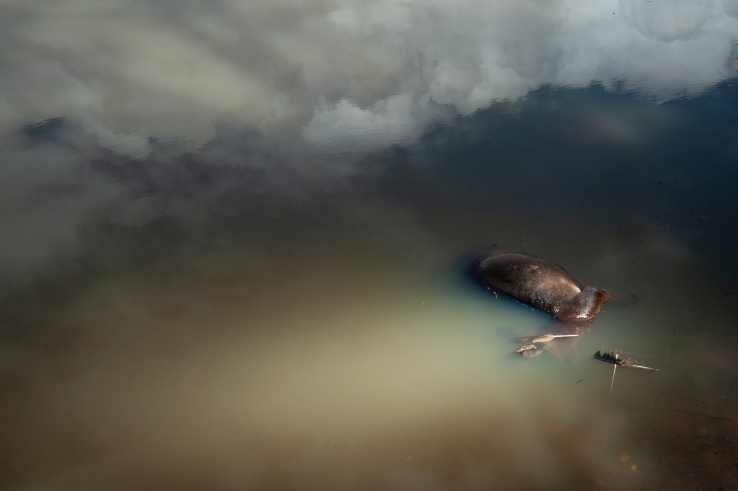
Drowned Kangaroo PHOTO: Julie Millowick
.
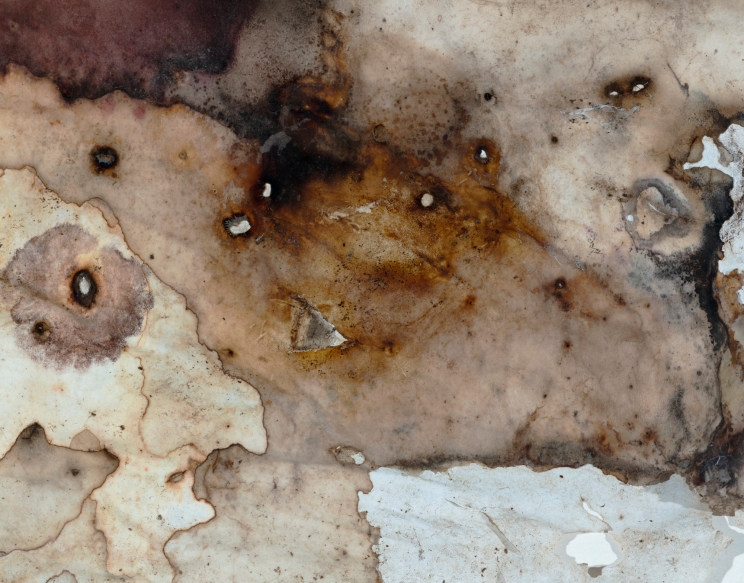
Lumen Buried Paper Under Blackberry Bush by Julie Millowick
.
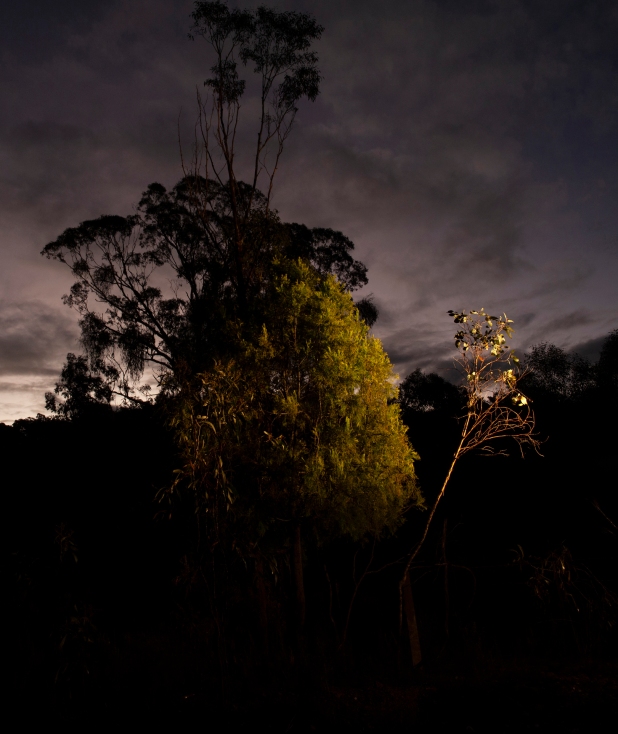
Castlemaine Diggings National Heritage Park Cherry Ballart 2022 PHOTO: Julie Millowick
.
A photographer with less time moving over the space would document the superficial surface of things and create a record time-locked to when they were there. Millowick has set for herself the challenge of distilling a life of experience of time and place by using her comprehensive knowledge of photographic techniques* that, when combined with personal vision, can present to the viewer something deeper. As Millowick explores the environment or found objects, she reveals deeper layers and meanings through her experimentation with the visual language of each process and technique. The depth and complexity of this work tells of the unwavering commitment to her art, the community and the environment.
.
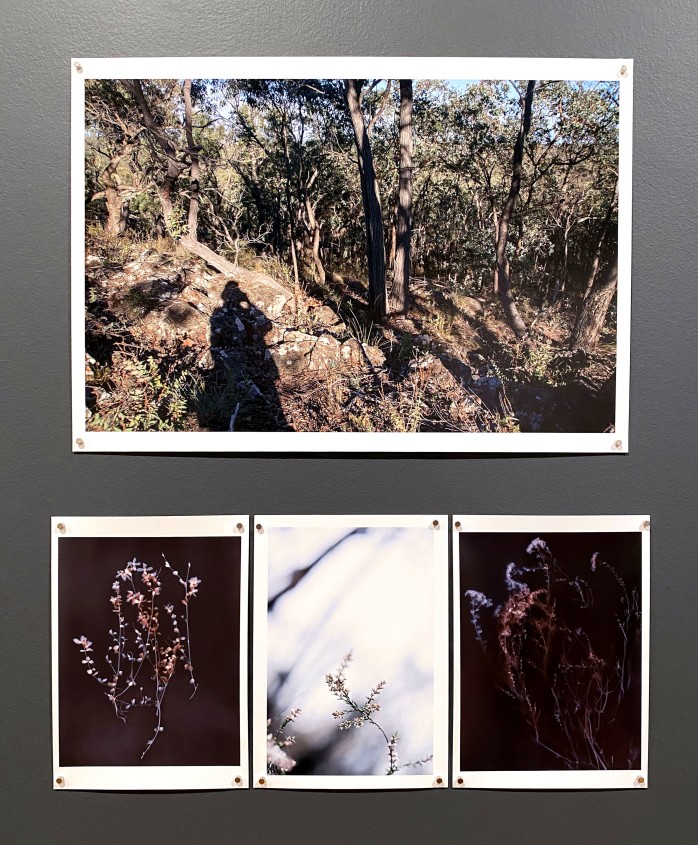
Image grouping
.
When introducing Julie Millowick at a recent artist’s talk about her exhibition the Gallery Director Naomi Cass described her as a ‘Localist’. ‘Localist’ is indeed an appropriate term not only for the work in this exhibition but also for Millowick’s continued photographic activity in the community. As a localist Millowick’s activity is part of the growing contemporary global movement for living locally and telling local stories particularly since the impacts of the Covid Pandemic. As it was 36 years in the making, this exhibition could only be just a fragment of Millowick’s creative visual documentation of her surroundings and community. Further digging or mining of her extensive archive will potentially reveal new perspectives and meanings on these powerful local stories of her place. Surrounding is just a beginning, there are so many other stories yet to be told …
.
A commentary on the exhibition by Victoria Cooper and Doug Spowart
Surrounding was part of the PHOTO2024 program
.
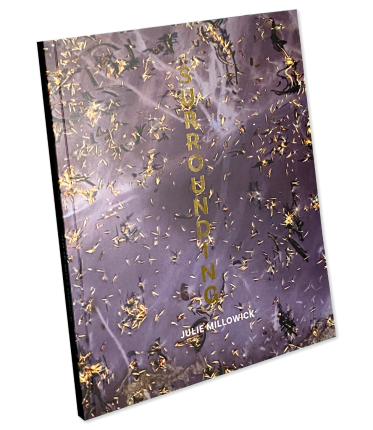
Surrounding – the book
.
P.S. The Surrounding exhibition is complemented by an illustrated book copies of which can be purchased from Castlemaine Art Museum or directly from Julie Millowick
.
IMAGES FROM THE IN CONVERSATION EVENT | Julie Millowick and Kyla McFarlane
Sunday 10 March, 11:30am — 12:30pm
.
.
* Photographic techniques that Julie Millowick employed in the exhibition include – pinhole photography, lumen printing, added lighting (painting-with-light), double exposure, cyanotypes, out-of-focus capture, re-photography, progressive sequencing, documentary and personal narrative.
We wish to thank Julie Millowick and congratulate her on the exhibition and for the images of her photographs and the exhibition installation. Photographs of the IN CONVERSATION event were by Doug Spowart.
Castlemaine Art Museum is a member of the Public Galleries Association of Victoria
.
.
.C
.
This site is archived by PANDORA, Australia National Library’s Web Archive
.
.
.
.
.
.
.
DOUG GOES WHERE THE SURFERS HAVE NO WAVES – Again…!
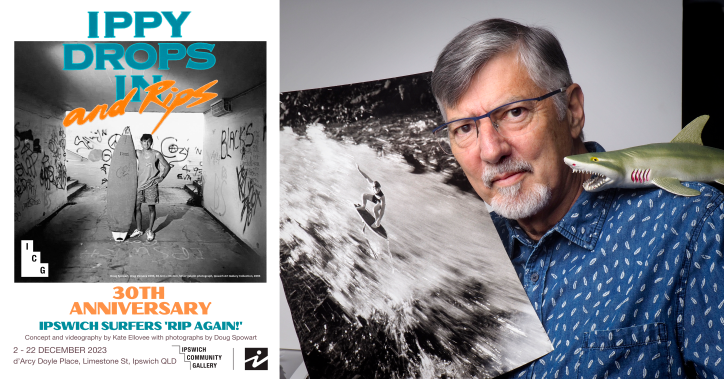
.
IPPY DROPS IN … AND RIPS!
The exhibition reprise after 30 years
.
THE PHOTOGRAPHIC COMPONENT FROM DOUG SPOWART: Read more later in the post
Click on the photo to enlarge …
.
.
THE VIDEO COMPONENT FROM KATE ELLOVEE:
.
The inspiration for the original exhibition was Kate Ellovee (Versace) who was working on a documentary project commenting on surfers who live at Ipswich and surf on the north and south coasts – much to the dislike of the locals. Entitled A Slagheap Safari the video takes centre stage in the reprise of the exhibition.
.
.
Kate’s A Slagheap Safari video can be viewed HERE
.
A mini booklet of the exhibition can be downloaded: Ippy Drops In and Rips Booklet
.
.
The exhibition will be on show in the Ipswich Community Gallery, d’Arcy Doyle Place, Limestone Street, Ipswich until the 22nd of December 2023.
.
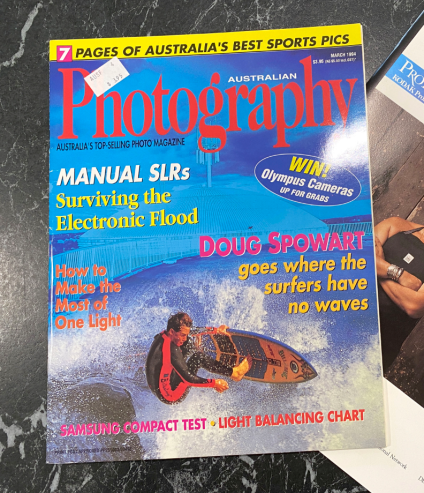
IPPY-Australian Photography Cover
.
Back in 1993 my work in the exhibition was featured in Australian Photography – the story inside added to the craziness of the whole project …
Click to enlarge text …
.
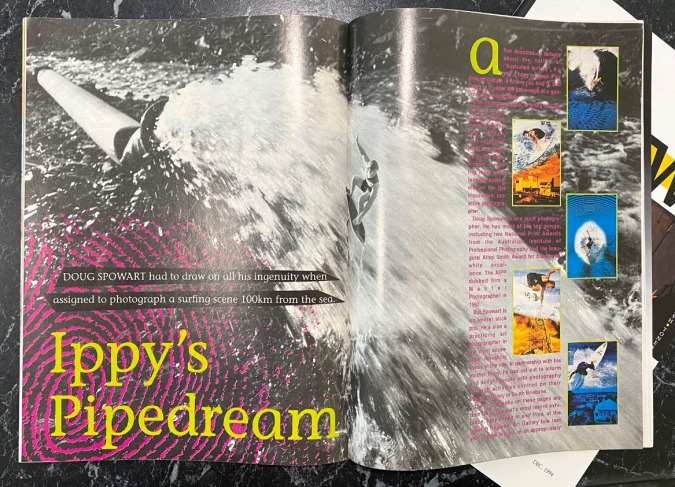
Australian Photography story p1 of 3
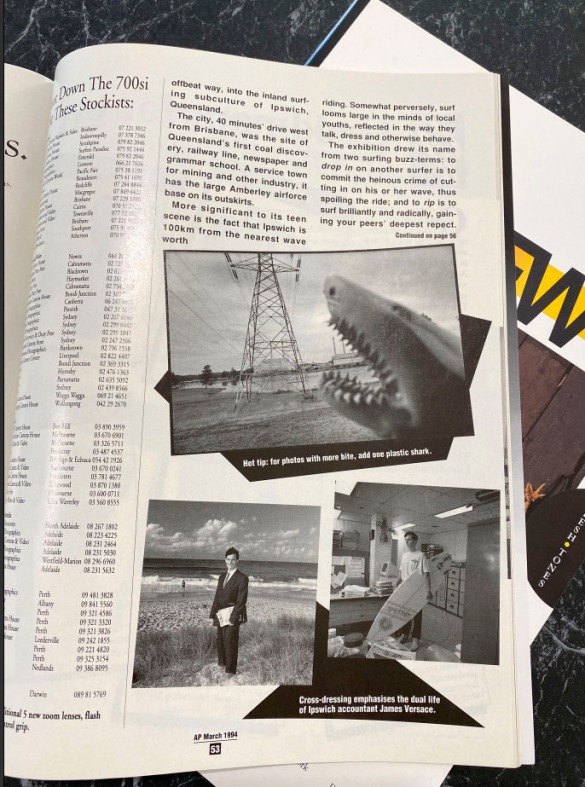
Australian Photography story p2 of 3
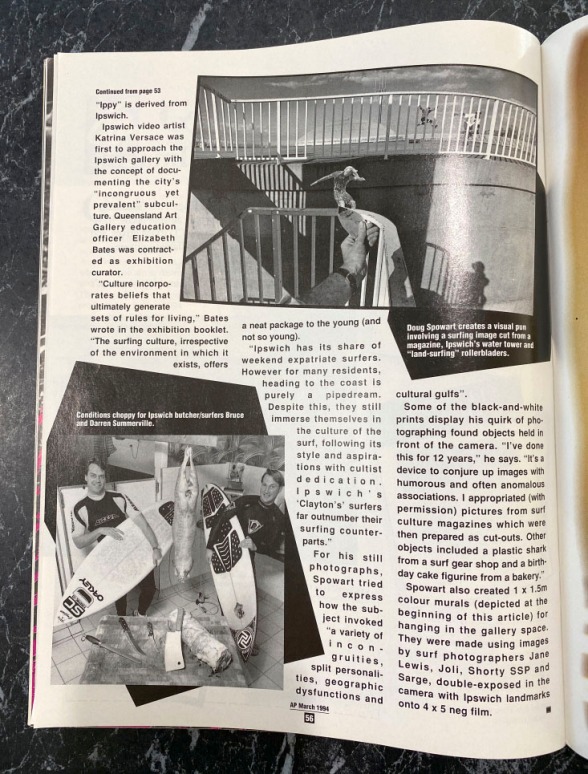
Australian Photography story p3 of 3
.
.
A reflection on the project by photographer Doug Spowart
Background to my work
I have a forty-year practice in conceptual photography. This approach to photography so profoundly directed my work that in the late 1980s my business card described my art practice as ‘Conceptual Photographer’. The methodologies of re-photography, photomontage sequential imaging and the use of a range of photo technologies and materials underpinned the conceptualisation, creation and presentation of the creative work. I look for the strange and the surreal or the sublime in everyday life addressed through irony and humour. I am always absorbed by how the mundane and ordinary can hold hidden moments of surprise if time is taken to see what is revealed.
The Ippy Drops in and Rips Project
In 1993 I received a phone call from Elizabeth Bates a curator at Ipswich Art Gallery. I had worked with Elizabeth at Araluen Art Gallery in Alice Springs a few years earlier on a documentary exhibition commenting on the tourist experience in Central Australia, so she was aware of the style of my photographic work. Elizabeth introduced the project she was working on with Kate Ellovee (Versace) in which Kate was to create a documentary video commenting on Ipswich’s landlocked surfers. It was suggested that I could create photography works that would complement the video presentation in the gallery. In the initial project development meeting with Kate she discussed the concepts behind the ‘A Slagheap Safari’ documentary video. Her project was full of the curiosity, irony, and humour that had resonance with my approach to documentary work.
My partner and fellow artist Victoria Cooper and I were intrigued by the idea that there was such a strong surfing culture in Ipswich. It seemed surreal to us and we wondered: where could we find a concept of surf or surfing in this mining town at the western edge of Brisbane? Who were these surfers and how did they navigate the cross-over from Ipswich to beach?
After contemplating these questions I put forward a proposition consisting of three concepts: (1) Re-photography portraits – commenting on the dual identities that surfers have living and working in Ipswich and yet maintaining a surfing life on the weekend down the beach, (2) ‘Hold-ups’, where I would search Ipswich town settings and mining landscapes for evidence or connection with the beach or surf and (3) Photomontages – through improbable interventions I would metaphorically bring the surf and surfers to Ipswich. Clearances were provided by surfing photographers and the pictured surfers for their photographs to be photomontaged with Ipswich location scenes.
In making the photographs we sometimes collaborated with Kate and at other times we worked independently. Kate’s energy and coordination skills were important to the project as surfers usually have one specific thing in mind – surfing. With Kate we went to the beaches to seek out these Ippy surfers in their preferred natural environment. In this quest we too “searched for the best waves” to find the surfers. Interestingly the Ippy project was pre the proliferation of mobile phones, so we needed to check the radio’s ‘best waves’ reports, we then went to the beaches and then looked out for the surfer’s cars, boards or the surfers themselves.
Working on the project’s themes Victoria and I would cruise around Ipswich looking for places that resonated with the concepts of beach and surfing. Gradually these were revealed to us: the top of a water tower with skateboarders, a tunnel leading into the mine, navigating a graffiti covered underpass, a mine cutting that looked like a wave. Each place we found was evocative and full of potential metaphors of surfing culture within this inland mining town.
A Concluding Comment
Documentary projects, either as video or photography, have the potential to tell stories and create a commentary on contemporary culture and social life. Thirty years on, the Ippy Drops in and Rips show returns to a new era, a new audience, and for those who participated in the original project, a possibility to recall memories of a different time.
In re-viewing Ippy Drops in and Rips Ipswich surfing culture story, perhaps not much has changed – or has it? Is the credo of the Ipswich surfing culture – surf to live and live to surf, still as strong as ever … ?
And finally … Do north and south coast locals cuss the new generation of Ipswich surfers when they “DROP IN … AND RIP …?”
.
.
Doug Spowart+ Victoria Cooper November 12, 2023
.
.
Thanks to Kate Ellovee for resurrecting the Ippy exhibition after 30 years and to Alison McKay and Ellia Shurte from Ipswich Art Gallery for their support with the exhibition. And also to Thomas Oliver and John Elliott for the photos.
.
.
.
MARTIN HANSEN MEMORIAL ART AWARDS: Our Works
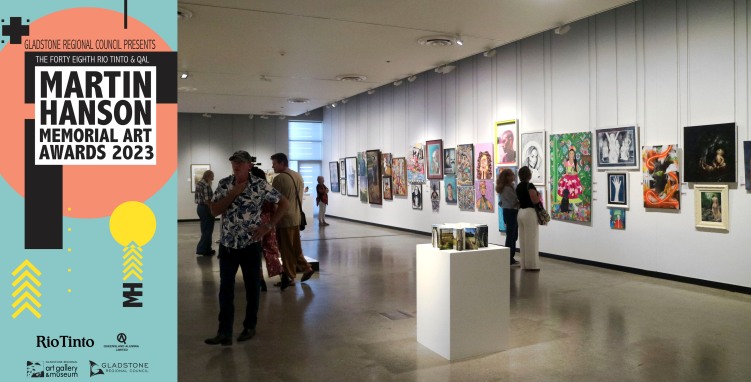
.
Once again we entered the Martin Hansen Memorial Art Awards at the Gladstone Regional Art Gallery and Museum. These Awards are the 48th event – Congratulations to the Gallery Team and the continued recognition of Martin Hanson’s early patronage of artists initiatives in Gladstone through these Awards.
For us each award entered is a place to present new works and their presentation – it is a challenge that hones our skills as artists.
.
This year Victoria’s entry was an artist book entitled String Theory Explained.
.

Victoria COOPER’s String Theory Explained presented
.Artist’s Statement:
String Theory Explained… its all about the unplanned and chaotic nature of everyday life… the beauty and terror within the order of “normal” existence.
.
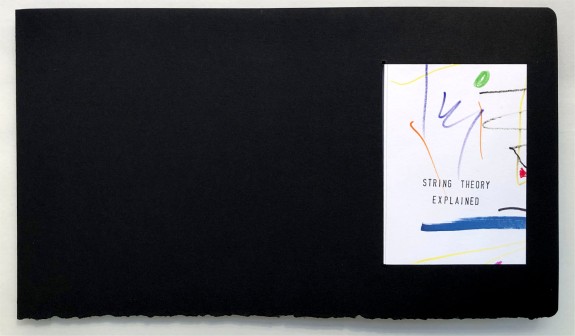
.
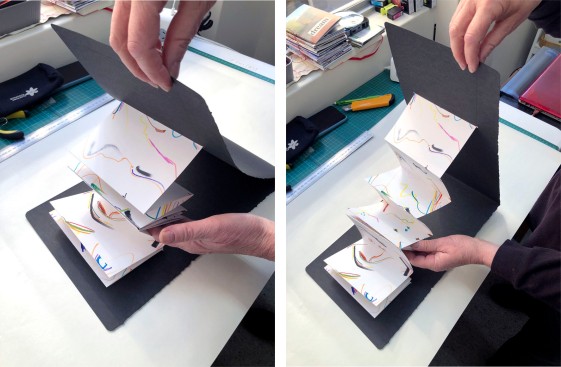
Opening up the book
.
Bibliographic Details:
Format: Concertina book embedded in folded cover
Media: various pen inks on art paper with Stonehenge black cover
Size: 764 x 230mm
.
.
Doug’s entry this year was Story Trees – First Nations a concertina artists book presented in a circular form.
.
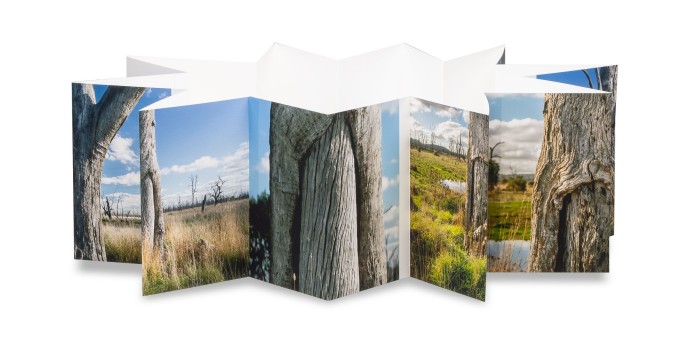
Doug SPOWART – Story Trees artists book
.
Artist’s Statement:
For me a poignant physical sign of First Nations presence remains embedded in the dead trees found throughout Mokoan. In witnessing these scar trees I found a profound sense of a time now passed and thoughts of the many stories that this place can tell.
This book was book two in a series of personal responses to encountering the locality of Mokoan and the Winton Wetlands. It was part of my contribution to the PALIMPSEST collaborative exhibition with Maggie Hollins and Victoria Cooper shown at Bainz Gallery in Wangaratta in August.
.
Bibliographic Details:
Format: Concertina book
Media: Pigment inks on photographic paper
Size in circular presentation: 600 x 700mm
.

Doug’s Story Trees installed at GRAGM
.
.
The Martin Hansen Memorial Art Awards exhibition will be on show until 2.00pm on the 27th of January 2024 at the Gladstone Regional Art Gallery and Museum.
.
Here is some information about the 2023 Awards and the Entry Form.
.
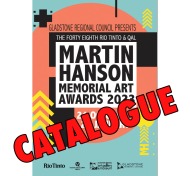 CLICK THIS LINK MH 23 Catalogue Online-r
CLICK THIS LINK MH 23 Catalogue Online-r
.
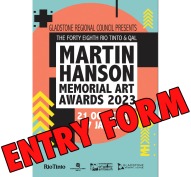 CLICK THIS LINK Martin Hansen Award 2023 Entry Details
CLICK THIS LINK Martin Hansen Award 2023 Entry Details
.
.
Photo of gallery installation courtesy of GRAGM
.
.
.
.
.
.
.
.
HILL END ANALOGUE: Our Cyanotype Works
We are excited to announce that a selection of our Cyaanotype artists books was presented at the Hill End Analogue event.
.
HERE’S THE BACK STORY
Hill End Analogue ( HEA ) is an analogue photographic arts festival presented by Hill End Arts Council Inc. ( HEAC ) in the Central West township of Hill End, N.S.W. HEA
showcased and connected contemporary analogue photographic artists world-wide. The event comprised exhibitions and workshops, the festival engaged with the general community, while promoting contemporary analogue arts and technology.
Hill End is an historic site, managed by N.S.W. National Parks Wildlife Service, and is significant in the history of Australian Photography. The documentation of Hill End and surrounds during the gold boom of the 1870’s by Beaufoy Merlin and Charles Bayliss, forms a large part of the Holtermann Collection in the N.S.W. State Library. Hill End has a thriving arts community, supported by the Bathurst Regional Art Gallery and is closely associated with the National Art School.
(Text modified from the HEA website)
.
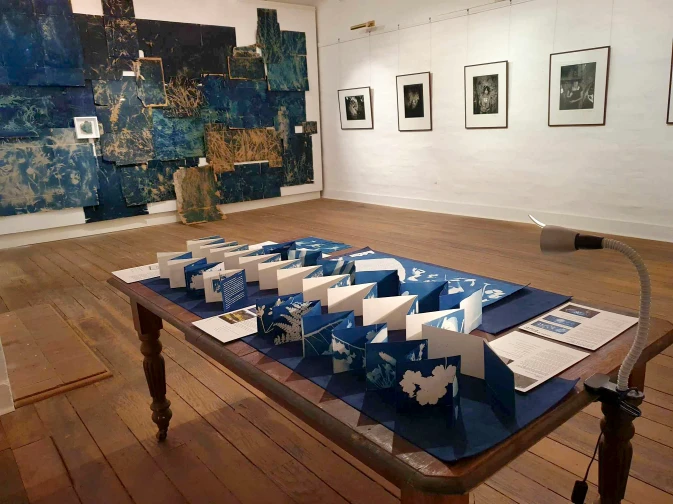
Hill End Analogue Installation PHOTO: Courtesy of Lisa Sharkey
.
OUR CYANOTYPES
.
MORE INFORMATION ON THESE CYANOTYPE WORKS
.
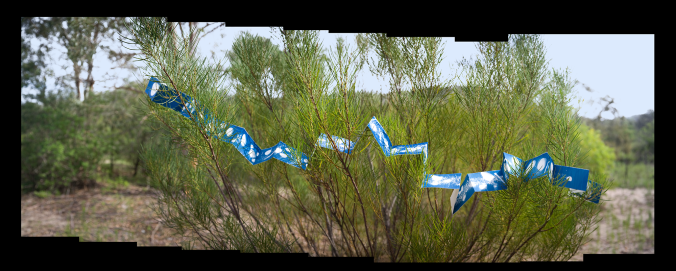
Victoria Cooper’s “Flood” in situ on the island Bundanon
.
FLOOD An artists book by Victoria Cooper
MEDIA: Concertina format with 26 pages, cyanotype on Arches watercolour paper with hand-set type in black ink
Binding by Doug Spowart
SIZE: 10 x 15 x 3cm cm
EDITION: Two unique states
Download a didactic about this book: COOPER – Flood installation at Bundanon
.
.
.
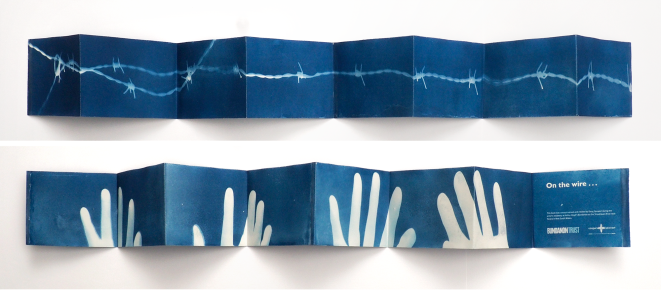
On the wire … A book by Doug Spowart
.
ON THE WIRE … A book by Doug Spowart
A performance based on open-air cyanotype bookmaking directly off subjects in the field.
CREATED: 2007 at Bundanon during an artist in residence
MEDIA: 16 sided concertina format book of double-sided cyanotype images on Arche Aquarelle watercolour paper
SIZE: 11 x 14 x .4 cm – extends to 116 cm
EDITION: Unique state 2 variants
Download a didactic about this book: SPOWART – On the wire – extended recto+verso
.
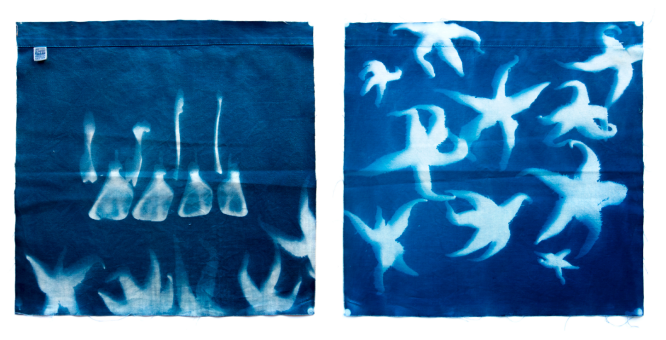
Starfish swarm with wallaby bones by Victoria Cooper
.
STARFISH SWARM WITH WALLABY BONES An artists book by Victoria Cooper
A double-sided cyanotype made from objects gathered in Tasmania. The work was made to celebrate the 2019 World Cyanotype Day.
CREATED: 2019 in Cygnet, Tasmania
MEDIA: Cyanotype on recycled linen pillowcase
SIZE: 30 x 30 cm
EDITION: Unique state
Download a didactic about this book: COOPER-Starfish swarm an wallaby bones
.
.

Roland Barthes an artists book by Doug Spowart
.
ROLAND BARTHES An artists book by Doug Spowart
Roland Barthes the French writer and theorist, has contributed significantly to the discourse and critique of photography. This book is a visual comment on two of his texts.
CREATED: 2017 at Bundanon during an artist in residence
MEDIA: Concertina format with 16 pages, cyanotype on Arches watercolour paper
Binding by Doug Spowart
SIZE: 11 x 14 x .4 cm
EDITION: Two unique states
Download a didactic about this book: Doug SPOWART -Barthes
.
.
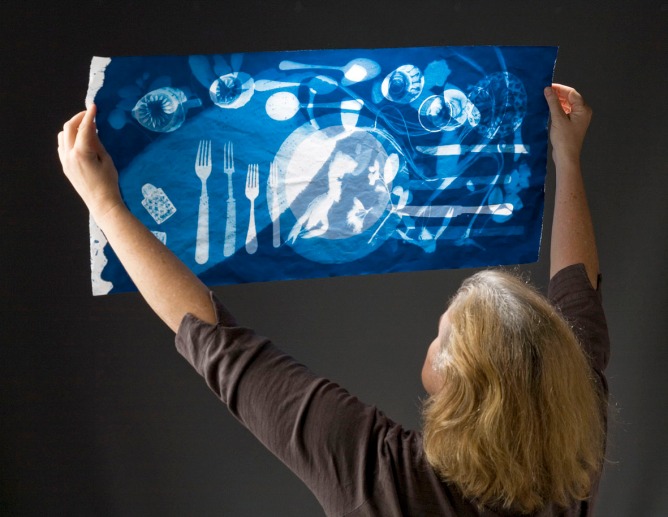
AUSTRALIAN BANQUET: January 26 / 26, 1788 by Cooper+Spowart
.
AUSTRALIAN BANQUET: January 26 / 26, 1788 by Cooper+Spowart
This work reflects on the ‘turning of the page’ in history that Australia Day represents.
CREATED: 2010 on Australia Day in Toowoomba
MEDIA: A unique state double-sided cyanotype on rice paper broadsheet of 7 variants.
SIZE: 37.6 x 77cm
Download a didactic about this book: COOPER+SPOWART – Australian banquet
.
.

PHOTOGRAPHS OF ARTHUR’S GARDEN A book by Doug Spowart
.
PHOTOGRAPHS OF ARTHUR’S GARDEN A book by Doug Spowart
A cyanotype concertina book made on the veranda of Arthur Boyd’s studio during an artist in residence
CREATED: 2007 at Bundanon
MEDIA: 24-sided concertina book. Cyanotype on Arche watercolour paper
SIZE: 11 x 14 x .4 cm – extends to 168 cm
EDITION: Unique state
Download a didactic about this book: SPOWART – Photographs of Arthur’s Garden – extended
..
.
.
.
.
THANKS TO: Lisa Sharkey and the Team for the opportunity to present these works at Hill End Analogue.
The photograph of the HEA installation courtesy of Lisa Sharkey
Text and cyanotype works and photographs © Doug Spowart+Victoria Cooper
.
.
.
.
TONES OF HOME: Cooper+Spowart in group show
.
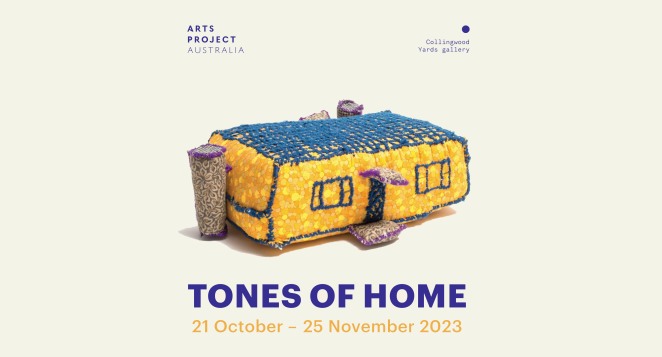
TONES OF HOME – Arts Project Australia
.
Tones of Home draws together artists from Arts Project Australia (APA), Melbourne, regional Victoria, and north Queensland to present works inspired by domestic and urban spaces. Curated by Eric Nash, Director Benalla Art Gallery the exhibition extends beyond these settings to consider ‘what makes a place, a home?’, touching on notions of family, community, belonging, connection, love, comfort, safety, and personal histories.
Featuring APA artists Steven Ajzenberg, Miles Howard-Wilks, Chris Mason, Chris O’Brien, Lisa Reid, Anthony Romagnano, Georgia Szmerling and Amani Tia alongside Atong Atem, Susie Buykx, Cooper+Spowart, Erub Arts Torres Strait and Ghost Net Collective, Aishah Kenton and Ron McBurnie.
(Text from the APA Website)
Tones of Home continues until 25 November 2023
.
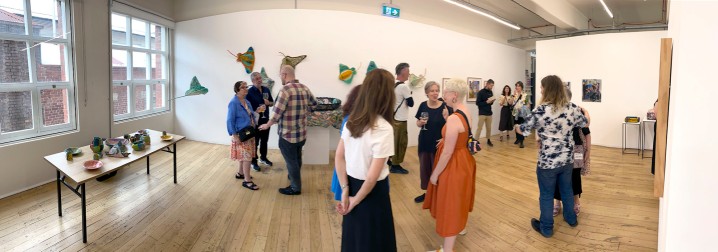
Tones of Home Exhibition
.
SOME COMMENTS FROM THE CURATOR – ERIC NASH
The seeds of this exhibition were truly sewn at home. As my wife and I awaited the arrival of our second child, I found myself considering a work by Mini Graff that hangs above our bed. It is a street art poster in a vintage drawing style. Text on the work reads ‘Today is my lucky washing day’, and a woman hangs washing on a clothesline while an atomic bomb appears to have gone off in the background. It seemed to resonate with my experience of our domestic bubble of safety, and, when at home, perhaps even my ignorance to the outside world.This caused me to ponder what ‘home’ felt like, and indeed meant, to others? It had to mean more than just somewhere we reside. I couldn’t help but imagine my favourite fictional retired barrister, Lawrence Hammill QC, declaring, “You can acquire a house, but you can’t acquire a home”.
I owe a debt of gratitude to the Arts Project Australia team and artists who kicked this project off by sharing their thoughts on the topic of home. A number of responses stuck with me and have framed the exhibition. Home, in their words, could be “where the most important people in your life are”… “where you feel safe”… “a base where you start from”… “a place that fits your ideas of design,
location, and convenience.” Common themes emerged, specifically ‘Personal histories’; ‘Love and family’; ‘Community and connection’; and ‘Belonging, comfort and safety’. …READ MORE FROM THE CURATOR – Download the exhibition Catalogue
“CLICK LINK” TonesOfHomeCatalogue_Web
“CLICK LINK” “Tones-of-Home-Room-Sheet-2
..
SOME VIEWS OF THE EXHIBITION
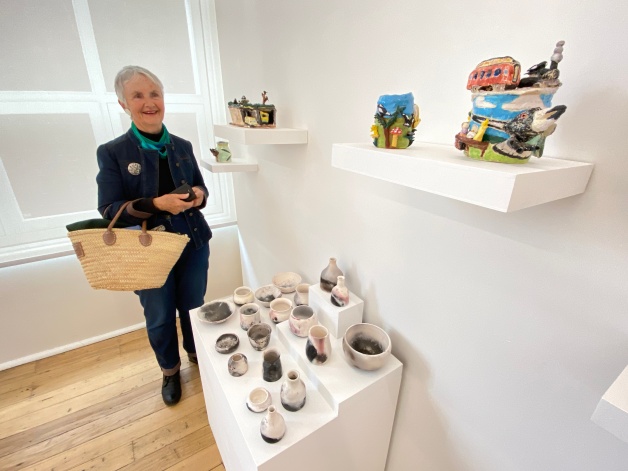
Susie Buykx and her ceramics
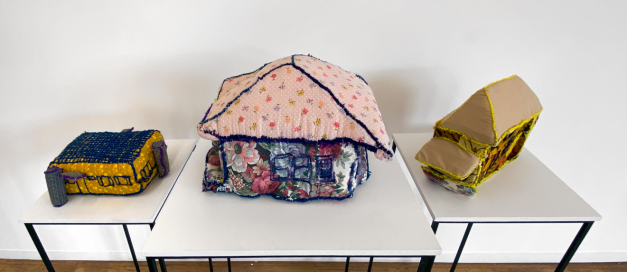
Chris O’Brien’s works
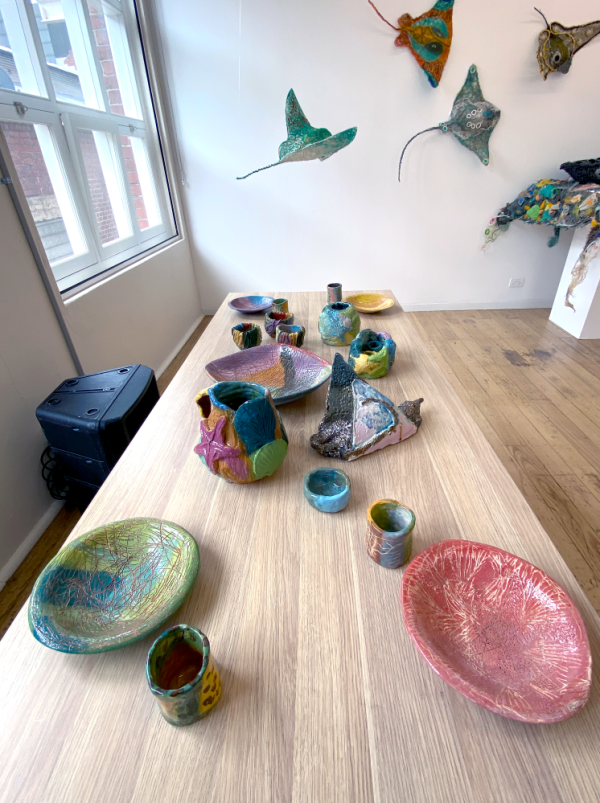
Georgia Szmerling ceramics (front) & Erub Arts Torres Strait and Ghost Net Collective (back wall)
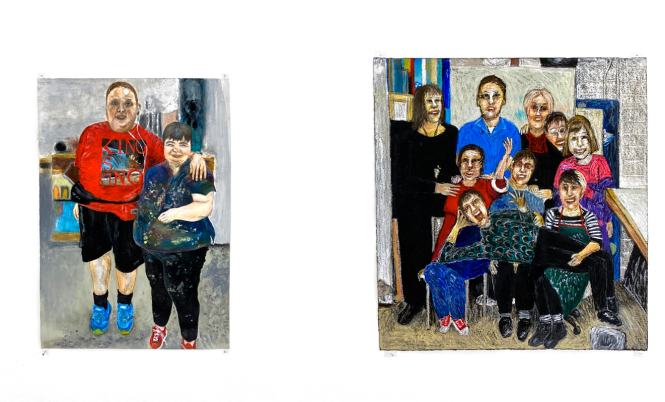
Chris Mason “Me and Monica Together” & “Me and my friends at work” 2019
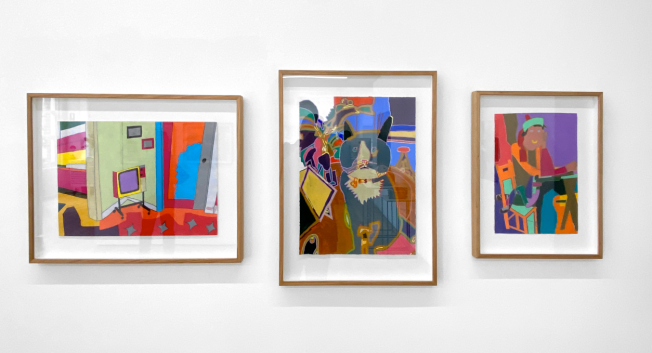
Anthony Romagnano’ works
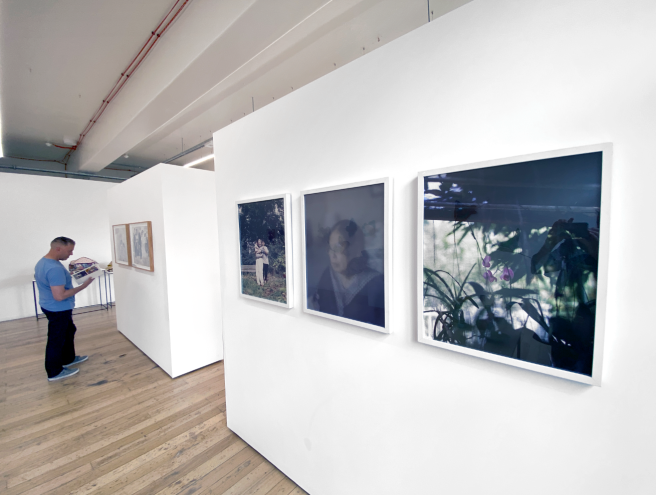
Aishah Kenton’s photographs
.
.
COOPER+SPOWART WORKS IN THE SHOW
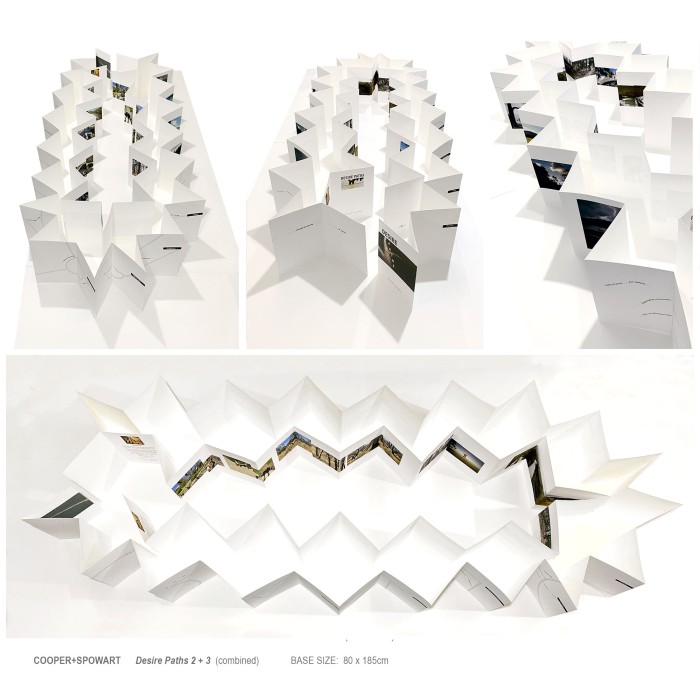
Cooper+Spowart “Desire Paths 2+3” Proposed layout
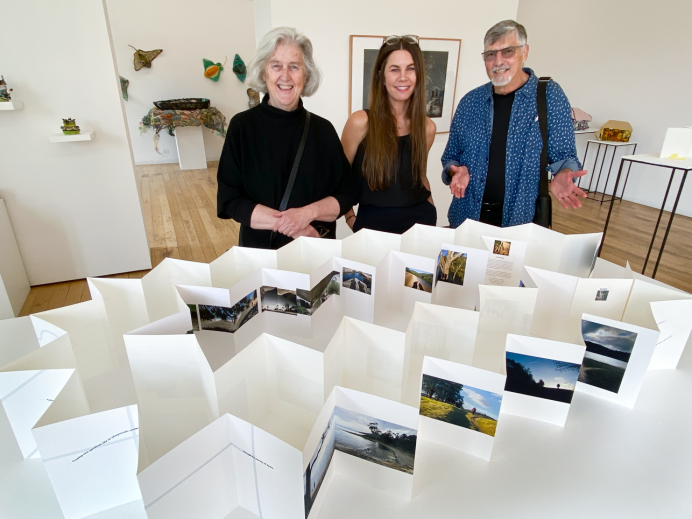
Victoria with Jo Salt Gallery Director + Doug PHOTO: Michael Coyne
C
COMMENTARY ON OUR DESIRE PATHS ARTISTS BOOKS…
Some words from Curator Eric Nash
… I write this essay now during paternity leave. This is the longest time I have spent consistently at home in years. This break and time with Tegan and our children brought something into clear focus: while Tegan and I have moved cities several times in the last ten years, I have always felt ‘at home’ as we have been together. Cooper and Spowart (Victoria Cooper and Doug Spowart) exemplify this through their extensive photography, photobook and artists book practices, which are maintained both as individual practitioners, and as life collaborators. For these artists, ‘home’ “was an idealised state of being in Place, which offered a sanctuary and a garden. More than architecture, ‘home’ is also a psychological and sensorial place for the safe shelter ofmemories and experiences.” (4)
Cooper and Spowart’s recent Desire Paths books resonate with their shared life and artistic journey, explaining “Our artistic process is also defined by the desire to discover new paths around the traditional norms. Over time these new paths become alternative solutions to the ultimate desired outcome. All these paths or lines are theexistential experience and representation of desire.” (5)
1.The astle (1997) Directed by Rob Sitch. [Feature .ilm]. Sydney, NSW, Australia: Roadshow Entertainment.
4 & 5. Cooper, V and Spowart, D (2023) Email to Eric Nash, 27 August.
.
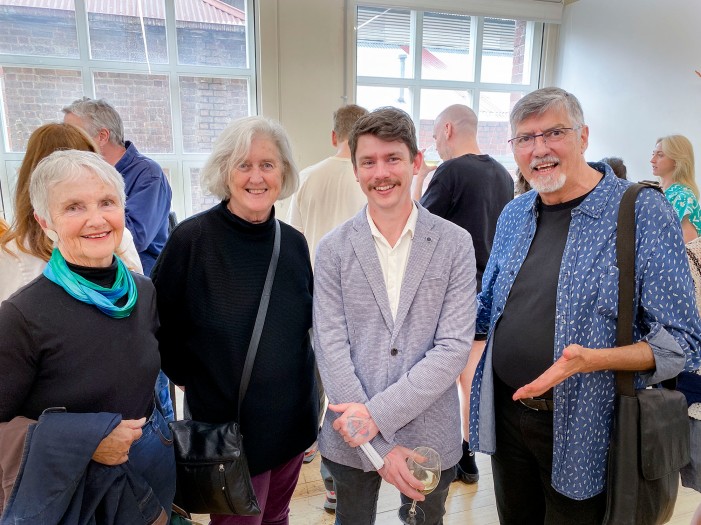
Susie Buykx+Victoria+Eric Nash (Curator) +Doug
.
Thanks to Eric Nash, Jo Salt and the Team at Arts Project Australia for the opportunity to to show work in this exhibition in Melbourne (Naarm). N
.
.
.
Unless noted otherwise photographs are by Doug Spowart
.
.ash
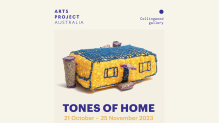
.
.
.
.
.
.
MAGGIE HOLLINS: An artist in the Winton Wetlands
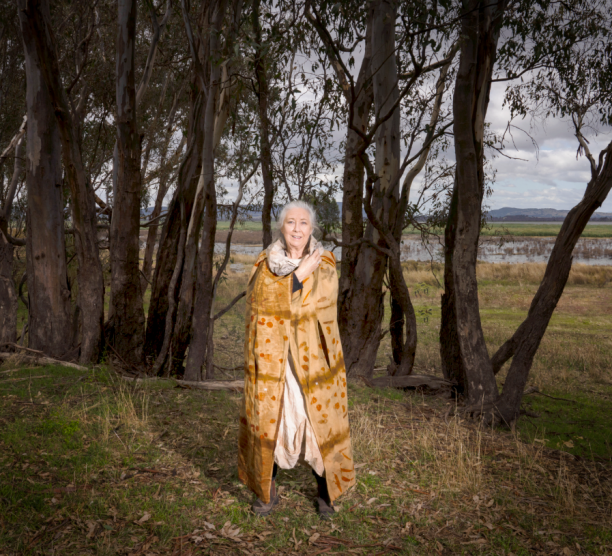
Maggie Hollins in Winton Wetlands Photo: Doug Spowart
.
In my current practice I aim to observe, absorb, and have a conversation with, a place. I document the physical and intangible qualities of the landscape and use the materials I find at that place to honour its essence. I want to draw more attention to the need for a biotic interaction with our surroundings.
Since 2016 I have been inspired by the Winton Wetlands. I have documented the changing seasons and evidence of previous habitation at the Winton Wetlands with my photography. My engagement with the Winton Wetlands has led to the creation of woollen wall hangings and ephemeral artworks at the site. Found materials I have used in this exhibition will also become ephemeral works when I return them to the Winton Wetlands.
I have long been aware of the Winton Wetlands but it was not until 2016 that I engaged fully with the site. I visited the site often and became a Friend of the Winton Wetlands which allowed me to see some projects up-close being completed. I did some ephemeral works at the site and some felted works inspired by the wetlands. One felted work is included in this exhibition.
2022 saw my renewed interest in the site and together with colleagues, Doug Spowart and Victoria Cooper, we set out to discover the intricacies of site. This exhibition is the result of our collaboration.
.
ABOUT MAGGIE HOLLINS’ WORKS
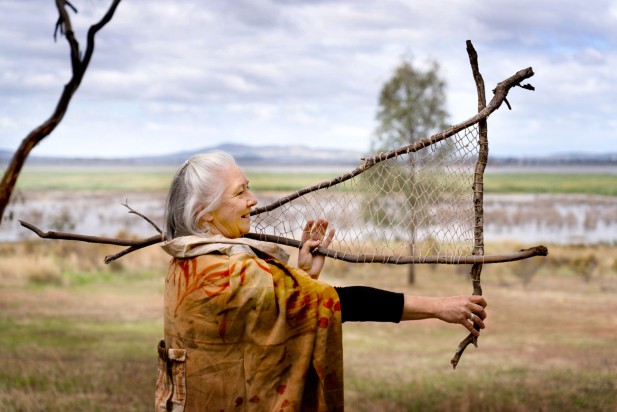
Maggie Hollins with “Harmony” PHOTO: Doug Spowart
.
Guided by the water, tree branches and barks, fallen feathers, leaves and grasses, I have participated in the narrative of the Winton Wetlands.
.
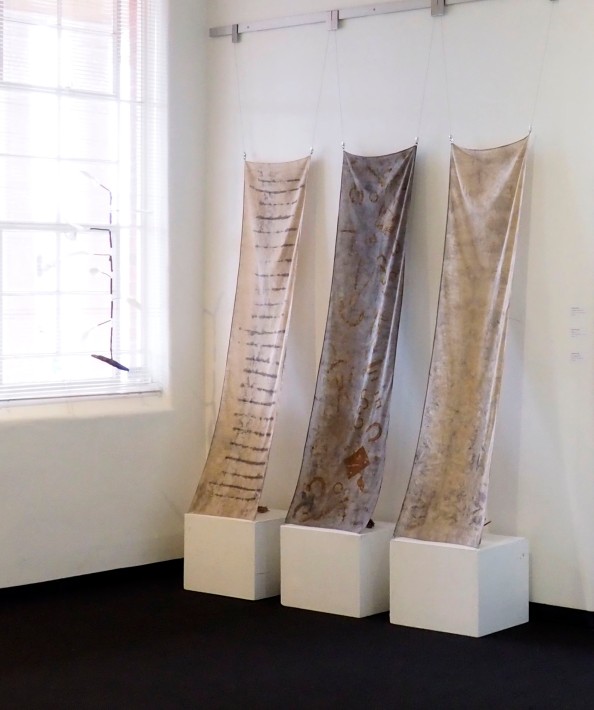
Maggie Hollins’ ‘Recognition of the Past”, “Shelter” &”The Dead Stags”
.
These natural elements, coloured ghostly grey on my textiles are a spectral testimony to their origin. The found metal shards authored the presence of others’ existence and together with the natural elements these works were fused by the hot sun. My textile works aim to celebrate the resilience and vitality of the wetlands ecosystem while eliciting the many distant voices of this special place.
.
.
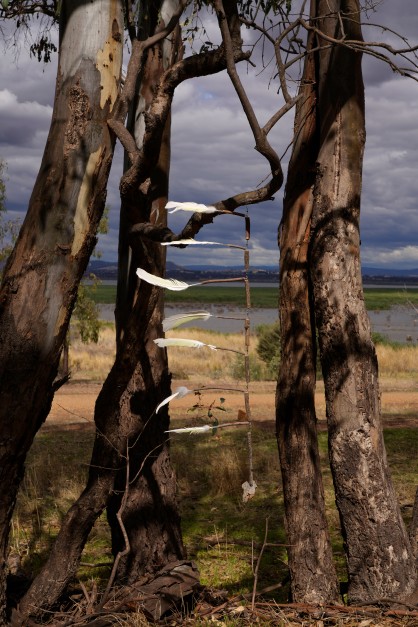
Maggie Hollins “Drifting on a Current” Photo: a collaboration
.
Feathers drift and amass in favourite resting places in the wetlands. I have often watched in awe at the murmuration of birds in the wetlands. My kinetic work aims to evoke a floating pattern of flight.
.
.
I have attempted to use my collage works as a metaphor for the layered past of the site to script stories of drought and flood, along with species that have occupied the wetlands.
.
.
The simple woven works aim to invoke the symbiosis binding all existence. The found materials will become ephemeral works when I return them to the site.
.
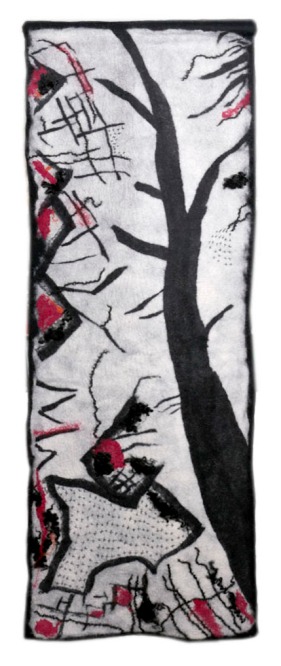
Maggie Hollins “Layers of the Wetlands”
.
CONTACT MAGGIE HOLLINS:
instagram.com/maggie.hollins and maggiehollins@gmail.com
.
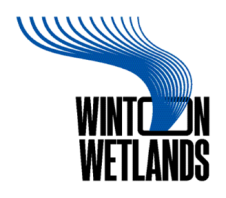
Winton Wetlands logo
FOR MORE INFORMATION ABOUT THE WINTON WETLANDS VISIT: https://wintonwetlands.org.au/
.
ACKNOWLEDGEMENTS
The artists wish to acknowledge the Winton Wetlands team for their support.
We acknowledge the traditional lands of the Yorta Yorta people & their 8 clans the original owners of Country.
We respect their deep enduring connection to their lands and waterways and recognise that sovereignty was never ceded.
We honour and respect their ancestors, their Elders past, present and emerging.
.
Most documentation photos and the video b Doug Spowart. The on-location photographs were a collaborative production by all 3 artists.
.
.
.
.
.
.
.
.
.
.
IN THE WETLANDS: 3 Artists – Cooper + Hollins + Spowart collaborate, drawing inspiration from Winton Wetlands
.
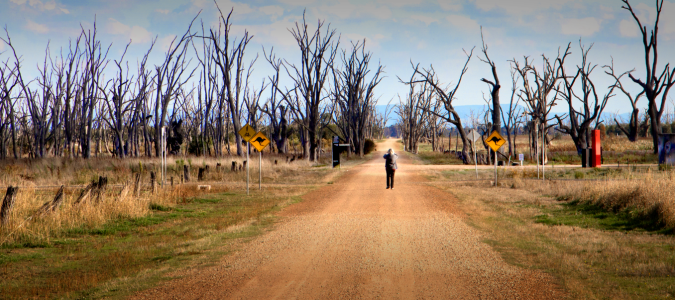
PALIMPSEST Exhibition artists in Winton Wetlands
.
The Winton Wetlands in north-eastern Victoria, also once known as Lake Mokoan, has been through many changes from farming to the building then decommissioning of a dam. Now this visually haunting and beautiful place is undergoing a new phase of regeneration – reviving the natural state of living wetland environment.
.
Dr Lisa Farnsworth, Winton Wetlands Restoration Manager, has been working with local artists to form a group that finds inspiration for their art in the Wetlands. She comments:
.
The Winton Wetlands Creatives Group is driven by a passion for the natural beauty and cultural richness of the Winton Wetlands Reserve. Through various art mediums and engagement opportunities, the group aims to advocate for the Winton Wetlands restoration project and for the ongoing protection and appreciation of its cultural and ecological assets. I’m genuinely excited to see how art, culture and ecology can align to create great outcomes for the health of our local people and natural landscapes.
.
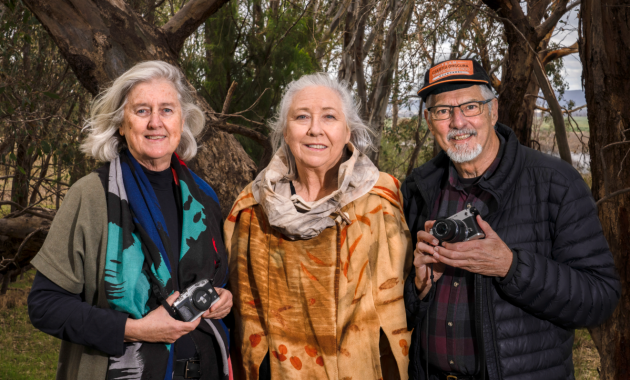
Artists Victoria Cooper, Maggie Hollins + Doug Spowart
.
In the spirit of Lisa’s vision we formed a collaboration with fellow Benalla artist Maggie Hollins to create a visual response to the Winton Wetlands inspired by its layered human and natural history and contemporary renewal. In our work we have associated this altered landscape with the concept of a palimpsest – a manuscript that was reused by writing new text over the previous words.
.
The Palimpsest features again in the exhibition where the collaboration between us as artists can be experienced as a layered narrative, where multiple stories and experiences intertwine to form a cohesive whole.
.
Check out our INSTAGRAM Project picture trail https://www.instagram.com/wetlands.palimpsest/
.
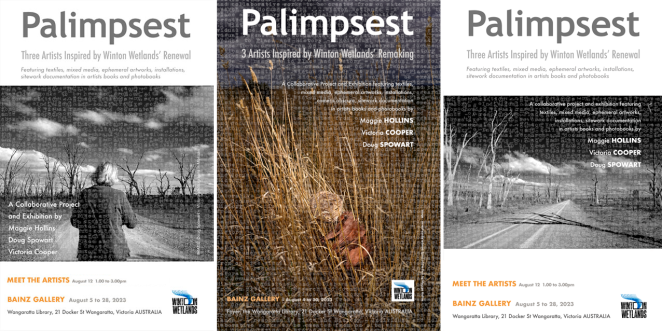
3 Invitations for the exhibition in BAINZ GALLERY in Wangaratta
.
.
SOME VIEWS OF THE EXHIBITION
.
.
SEE A FLY-THROUGH VIDEO OF THE EXHIBITION
.
.
.
A COMMENTARY ON THE EXHIBITION …
Victoria Cooper, Maggie Hollins and Doug Spowart have collaborated to produce and display a wonderful and diverse visual exhibition. They have sought to associate the altered Winton Wetlands landscape with the concept of a palimpsest. In doing so they are contributing to discussion of different, yet overlapping, stories of the wetlands.
Cooper and Spowart have been involved in the arts as practitioners, teachers and commentators for a lengthy time, including having residencies at Bundanon. Hollins has qualifications in ceramics, leads art workshops and enjoys playing fiddle. Unsurprisingly therefore, each and every artwork displayed is of a high standard.
There are unique, handmade textural and sculptural artworks by Hollins that use a diverse variety of materials – including found small branches, knotted bark, dyed cotton thread, solar and rust dyed cotton fabric, metal rings, and found grasses. They are accompanied by postcard sized images of the same artworks “displayed” on site in the wetlands. Those images were a team effort – Hollins operated the camera, Cooper was location scout and camera assistant, and Spowart did the lighting and Director of Photography duties.
There are larger standalone photographic prints and collaborative diptychs by Cooper & Spowart conveying stories of witnessing, magnificent 3 metre wide concertina photobooks by Spowart displayed folded out and attached to the wall, plus artist books and poetry by Cooper.
It all comes together splendidly, successfully conveying the messages the artists want visitors to hear.
.
BRIAN ROPE Reviewer for and member of the Canberra Critics Circle
Read Brian Rope’s full review HERE
.
.
LATER POSTS WILL FEATURE MORE ABOUT THE INDIVIDUAL ARTISTS & THEIR WORKS …
.
.
.
SEE MORE ABOUT THE WINTON WETLANDS …
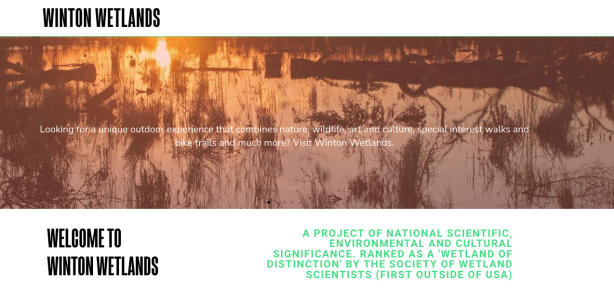
Winton Wetlands website Home page
CLICK HERE FOR THE WINTON WETLAND’S WEBSITE
.
.
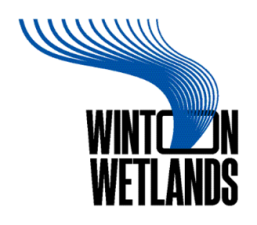
Winton Wetlands logo
.
ACKNOWLEDGEMENTS
The artists wish to acknowledge the Winton Wetlands team for their support.
We acknowledge the traditional lands of the Yorta Yorta people & their 8 clans the original owners of Country.
We respect their deep enduring connection to their lands and waterways and recognise that sovereignty was never ceded.
We honour and respect their ancestors, their Elders past, present and emerging.
.
.
.
.
.
CONCEPTUAL PHOTOGRAPHY PRIZE: The Mullins Conceptual Photography Prize – Muswellbrook Art Centre
.
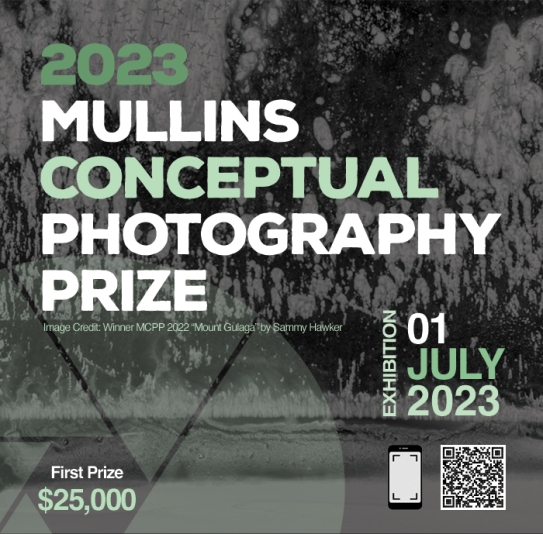
.
Recently we were part of the judging team for the 2023 Mullins Conceptual Photography Prize (MCPP) which is coordinated by the Australian Photographic Society. The Award is acquisitive and is offered nationally with a value of $25,000. The Mullins Prize seeks to find Australia’s best conceptual photographic works where the means of work presentation are unrestricted, inviting photographers to illustrate the intent of their works through a myriad of mediums. The finalists are exhibited and judged at the Muswellbrook Regional Arts Centre.
.
.
.
.
JUDGE ELOISE MAREE’s PRIZE ANNOUNCEMENT SPEECH
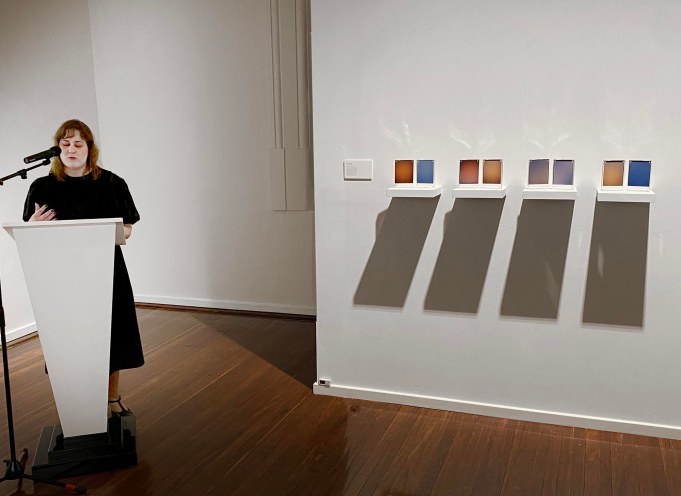
Eloise Maree announces the winner
It’s been a pleasure and a privilege judging the 2023 Mullins Conceptual Photography Prize here at Muswellbrook Regional Arts Centre, on Wanaruah Land. I’ve really enjoyed observing the ways in which the works dialogue with one another, as well as the dialogue they bring about in their observers.
I am pleased to announce that CHRIS BOWES is the WINNER of the 2023 MCPP with his work SUN KISSED #1–4. The fact that Chris Bowes has two works within this finalists exhibition is a testament, I feel, to the strength of his artistry.
Sun Kissed #1-4 is concurrently simple – coloured film imprinted with light as the sun rises and sets – and complex – non-representational landscapes, at once simulacras and originals, motion and stasis, photography and meteorology. Congratulations on beautifully distilling and expanding the definition of landscape photography.
Chris Bowes is a multi-disciplinary artist based in Naarm (Melbourne), on the unceded lands of the Kulin nation. Bowes is a first time MCPP finalist and receives the 2023 MCPP $25,000 cash Prize.
.
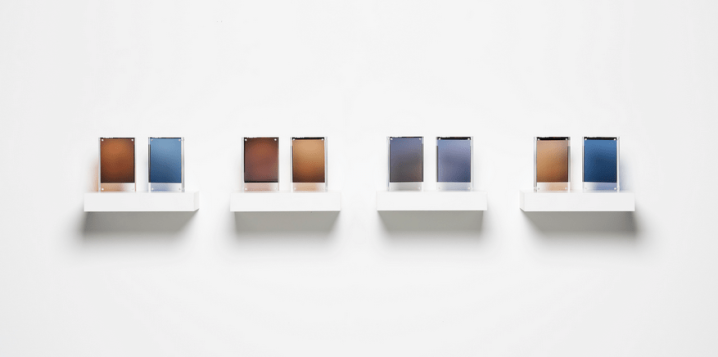
Chris Bowes Sunkissed #1–4
.
ARTISTS STATEMENT: “Sun Kissed” is a series of experimental photographs created using a hand-made camera that, rather than capturing a representational image, instead captures the colour of light. They are presented in pairs, each pair containing an imprint of the light at sunrise and sunset over the course of several days. As such, the work’s aim is to reduce landscape photography to its most basic form, imbuing photographic film with an impression of the sun rather than capturing it washing over the environment.
.
.
.
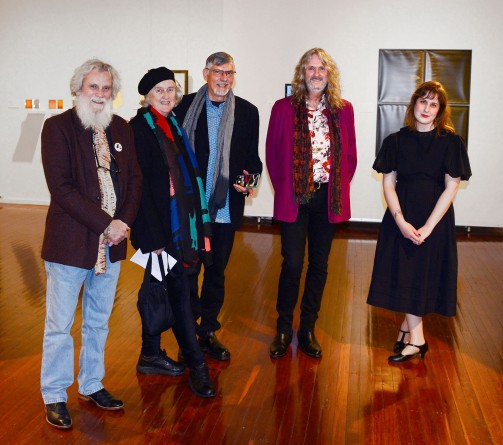
Roger Skinner with the Adjudicators
.
COMMENTS ON THE ADJUDICATION BY JUDGE LEN METCALF
The 2023 Mullins Conceptual Photography Prize is an incredible and important exhibition. It shines as the leading art photography prize, and as such is a showcase of what photography can be. That is the point of it isn’t it? To question what photography is, to push the boundaries into new areas, to test assumptions and explore the photographic visual medium beyond its established boundaries. The resulting exhibition does this exceptionally well.
This visually stimulating, emotionally charged and intellectually challenging exhibition is the culmination of a long judiciary process. Firstly 450 entries are digitally catalogued and the adjudicators, Eloise Maree, Victoria Cooper, Doug Spowart and myself (Len Metcalf) carefully start examining each entry. We carefully considered each of the artworks, the multiple images that accompanied many of the works, sizes, the titles, and the artists statements. From here we all picked a selection to be a finalist and to be exhibited. Interestingly, there was only one overlapping artwork, a testament to the diversity in background and aesthetics of the panel, but most importantly to the diversity and quality of the entries.
Thirty artworks were bought together for the exhibition at Muswellbrook Regional Arts Centre, an interesting and stimulating mix of work. As we wandered around the exhibition the quality and the breadth was overwhelming. As was the daunting task of choosing only one winner. I joked that we could randomly choose a winner and argue how deserving it would be.
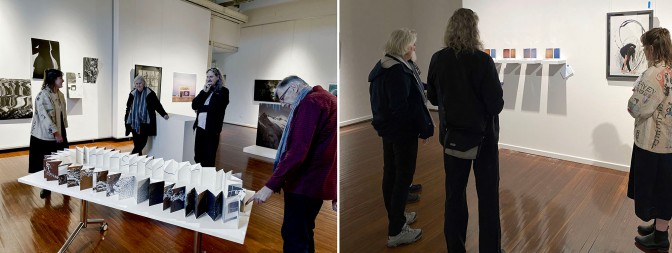
Adjudicators deliberating
The adjudication panel, over the better part of a day, wandered around and discussed every artwork in depth. Examining in detail, considering the artwork in front of us as it was presented. It was mentally exhausting and incredibly rewarding.
When we came together, reflecting on all of those conversations, there had been one artwork where all the judges glowed as we hovered around it, the conversation was stimulating and illuminating inspired by the artwork. A quick check with all the judges and the decision was unanimous.
The judges agreed to each choose their own to add four additional highly commended awards.
.
.
.
ABOUT THE HIGHLY COMMENDED AWARDS
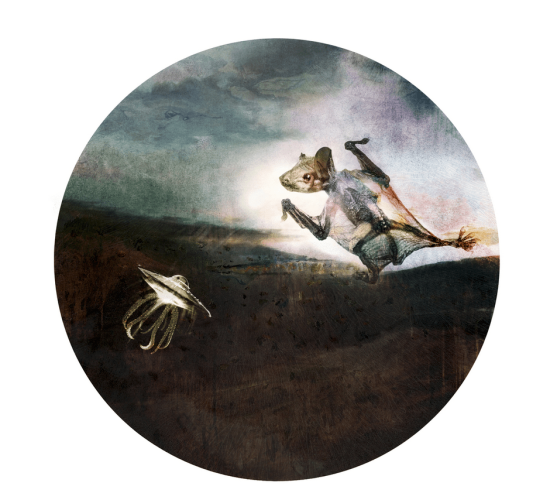
Judith Nangala Crispin’s A flying saucer over Clyde Mountain, shows Declan, dead at two hours old, how to make a new body out of light
Judith Nangala Crispin A flying saucer over Clyde Mountain, shows Declan, dead at two hours old, how to make a new body out of light
.
Doug Spowart comments on Judith Nagala Crispin’s Highly Commended work
The very name of this prize ‘Conceptual Photography’ demanded of me to seek out works that went beyond the reality of normal visual captures and that dealt with and idea transferred to a photographic outcome. Though Crispin’s work is firmly embedded in a range of photography and, perhaps even pre-photography techniques what excites me is the caring and poetic narratives she creates that connect the death of the animal recorded and its spiritual resurrection.
ARTISTS STATEMENT: This is part of a series of afterlife portraits of birds and animals, ascending between earth and outer space. I place cadavers on emulsion, creating images with a Lumachrome glass printing sun printing, cliché-verre and chemigram. Decomposition chemistry creates colour and detail. Each print is exposed 30–50 hours in natural light. This work draws on my experience of tracing my family’s Aboriginal ancestry. I am trying to honour the lives of animal and birds with whom we share this planet.
.
.
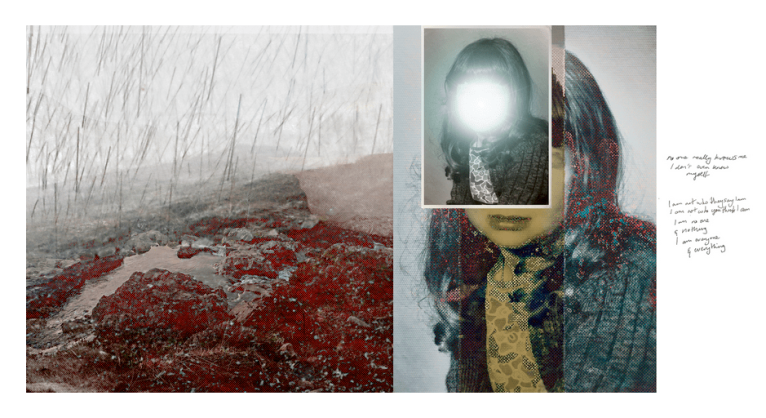
Arrayah Loynd’s I don’t always understand/selectively mute (diptych)
Arrayah Loynd I don’t always understand/selectively mute (diptych)
Victoria Cooper comments on Arrayah Loynd’s work
This work is hard to walk past but equally hard to look at. The artist’s statement and title resonates with the images. Loynd embedded concepts of identity, crisis and trauma in the layers of this deeply confronting work.
ARTISTS STATEMENT: I don’t feel like I belong in my body, it feels awkward and uncomfortable like an ill fitting suit. I live in a constant state of confusion…of others, of myself. I am not who they say I am, I am not who you think I am. I am no one and nothing, I am everyone and everything, So come and find me, but only in the small moments when I want to be found. I make no promise that I will be there. (neurodivergence/trauma)
.
.
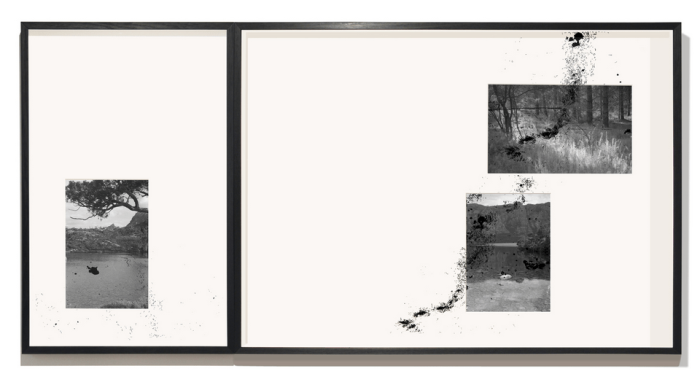
Melanie Cobram’s The Colony Reclaims the Land
Eloise Maree comments on Melanie Cobram’s The Colony Reclaims the Land
Within this work, Melanie’s photographically ‘captured’ landscapes are terrorised and territorialised by a colony of termites (I’d be curious to know if the termites were a native or introduced species). I really enjoy the way the termites’ interventions extend beyond the photographic negatives to the matboard, just as this photoseries extends discussions on migration, citizenship and belonging beyond the usual frames of reference. Congratulations on creating such a thought-provoking work, Melanie.
ARTISTS STATEMENT: The Colony Reclaims the Land is a series of 35mm negatives depicting the Australian landscape, intervened by a colony of termites. The negatives were fed into a termite mound and crossed over by the colony as it travelled assiduously across the nest. The work plays with the dialogue of living on colonised land by inviting a native colony to reclaim its own image. The termites’ subtle topographical drawings reconcile landscape and language, eliciting conversations about migration, citizenship and belonging.
.
.
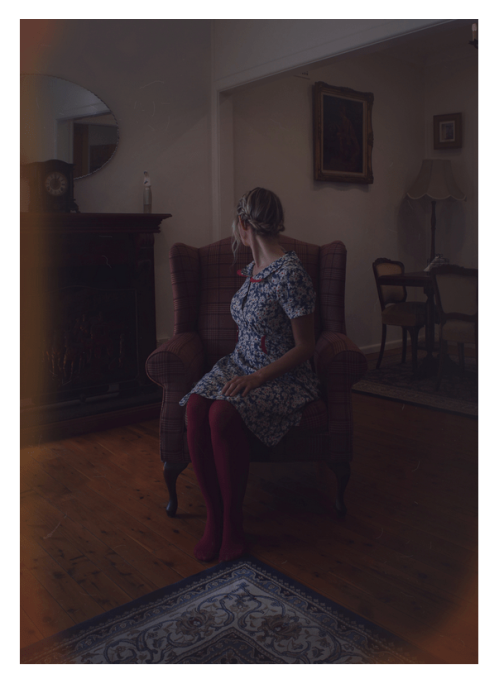
Jess Leonard’s I knew at the Time
Len Metcalf’s comments on Jess Leonard’s I knew at the Time
‘I knew at the Time’, by Jess Leonard is fascinating as it is one of the few artworks in the exhibition that adheres to a more traditional approach to the photographic medium. Or is it? The artwork and the narrative asks the viewer so many questions. Ones that remain unanswered by the work. We are left with discussions and questions. As the artists says in their artists statement, ‘themes of women, the body and place, memory and mystery… The story you walk away with is yours to believe.’
ARTISTS STATEMENT: Perhaps uncanny and slightly disorientating this work explores themes of women, the body and place, memory and mystery with only a fragment of the narrative presented before the viewer. The story you walk away with is yours to believe.
.
.
THE FINALISTS
Name Artwork Title
Alex Walker Manual Exposure
Anna Carey Crystal Mystery, 2022
Annabelle McEwen Self Scan B (photogrammetry)
Arrayah Loynd I don’t always understand/selectively mute (diptych)
Ben Kelly Dimension
Chris Bowes Dip/Dunk #1
Chris Bowes Sun Kissed
Chris Byrnes Beyond the Photogram Chasing Alison No 1 Dawn Light
Damian Dillon Bourgeois Cha Cha #7
Dave Carswell Flocculation #2
Holly Schulte Swell (37)
Jacinta Giles For the Birds?
Jenny Pollak Free Fall
Jess Leonard I Knew At The Time
Judith Nangala Crispin A flying saucer over Clyde Mountain, shows Declan, dead at two hours old, how to make a new body out of light
Katrina Crook Untitled#1 (In Silence)
Kelly Marie Slater Landshapes: Pass between Needles
Kenneth Lambert Burden of Proof (Data Portrait of Magdalene)
Kim Percy Sway
Marcus O’Donnell (De)Composition – a dark ecology
Matthew Schiavello Under the Sea
Melanie Cobham The Colony Reclaims the Land
Nicholas Hubicki Vitichiton (the end of the forests)
Nikky Morgan-Smith Index
Peter Rossi Unchopping A Tree
Regina Piroska I Followed A Worm (accordian book)
Stephen Blanch The Acrobat and the Flea (Flood Loss, Lismore 2022)
Tebani Slade Of me in the landscape
Wouter Van de Voorde Uncontrolled
Yianni Maggacis The Good Room XII
.
.

Chris Bowes 2017 PHOTO: Doug Spowart
.
CHRIS BOWES’ COMMENTS ON RECEIVING THE PRIZE
Published on his social media after the Prize’s announcement …
Chris Bowes’ @quisbie
Well, this was a pleasant surprise.
I’ve been making art for over a decade, and yesterday was probably the highlight of my career so far. Ever since I made my first conceptual project Sweat nine years ago, I’ve been wanting to create a process that captured some of those ideas using ‘landscape’ photography. When I first picked up a camera 15 odd years ago, my main interest was shooting landscapes. This focus transitioned to conceptual photography while I studied, and it completely changed the way I viewed and used the medium. What I’m most excited about is that this prize money will go back into the photographic community by supporting my new venture @kindredcameras.
It feels really validating to win a competition like this, but I feel conflicted about competitions because while I’ve come out on top, there are lots of other amazing artists who were just as deserving of the win. I want to acknowledge the significant time and money that artists put into being a part of these things with the unlikely hopes that they’ll win the big prize. It’s often a huge financial burden and an emotional rollercoaster. The work from all the other artists in the show is incredible, and I hope you go and have a look at their practices
.
.
ABOUT THE ADJUDICATORS
.
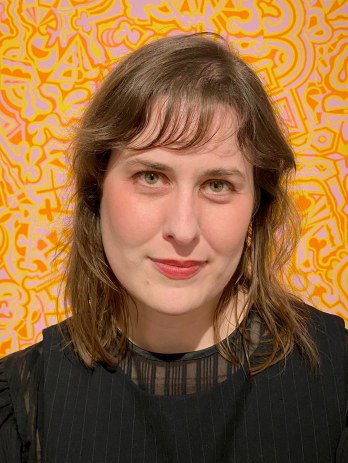
Eloise Maree PHOTO: Doug Spowart
Eloise Maree
Eloise is an artist and arts worker privileged to be living and working on and with Gundungurra and Wiradjuri land (Blue Mountains and Bathurst, New South Wales).
Eloise is a photographic artist utilising wet plate photographic processes. Eloise is interested in the relationships between people and place, in the history, and historical processes, of photography and in ‘creative histories’. Eloise’s camera-original wet plate photographs are both historical (hand sensitised using a silver nitrate solution, for example) and contemporary (shot using modern lenses, for example, and or lighting). This locates Eloise’s photographic art in the past as well as the present, and this colocation enables Eloise’s revisionings of histories and archives.
Eloise is experienced by way of Craig Tuffin as well as by way of Ellie Young of Gold Street Studios, a Bachelor of Visual Arts (Honours) (Sydney College of the Arts, the University of Sydney) and a Master of Museum Studies (the University of Sydney).
.
.
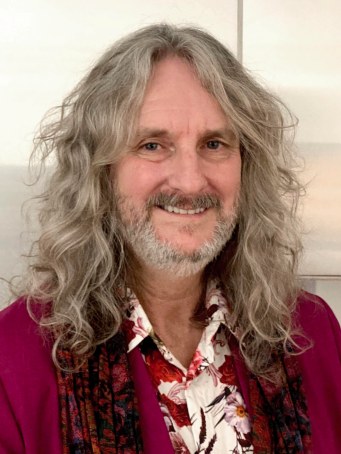
Len Metcalf PHOTO: Doug Spowart
Len Metcalf
Len’s journey towards photographic education began long ago, with the gift of his first camera as a young boy in the Blue Mountains, and his first teaching experience in a local Scout troupe at fifteen years old. After graduating from High School, Len took a job as an outdoor educator in Kangaroo Valley to support himself through a Visual Arts degree, majoring in Photography.
This was the beginning of a lifelong quest to combine his passions for adventure, education and photography. While studying Fine Art, Len had the opportunity to learn from fine teachers such as George Schwartz, Eardly Lancaster Julie Brown-Rrap and Lynn Roberts Goodwin at the City Art Institute (now Faculty of Fine Arts at NSW University).
He graduated with straight distinctions and received the coveted award for ‘Most Outstanding Advanced Colour Photographer’. Turning down two corporate photography sponsorship offers, Len instead pursued a career in education and outdoor adventure. Photography became his unbridled passion and his escape from work. During his 30-year career in the education sector Len worked with numerous schools and businesses as an experiential educator, facilitating learning outcomes through experiences in the outdoors.
In the tertiary education sector Len worked at the University of Technology, Sydney in the Faculty of Adult Education as course coordinator and lecturer in the Bachelor of Teaching program. Later, he took on a role in the TAFE system as a vocational trainer designing, developing, coordinating and running some of the best industry courses in the world for over twenty years.
After 30 years as a facilitator, educator and trainer, Len was ready to pursue a new direction. He completed a Graduate Diploma in Art Education at Sydney University and a Masters Degree in Adult Education at the University of Technology, Sydney. In 2000 Len founded Len’s School. Since then he has been teaching, mentoring and guiding photographers in some of the most spectacular landscapes in Australia, from arid deserts and windswept coasts to his backyard in the Greater Blue Mountains World Heritage Area.
.
.
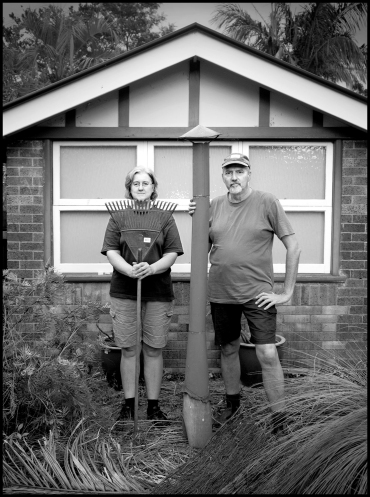
Cooper+Spowart PHOTO:Spowart/Elliott
Cooper+Spowart
Victoria Cooper and Doug Spowart are visual artists with an extensive practice as individuals and in collaboration. Both have completed individual PhD studies in photography, photobooks and artists’ books. Cooper and Spowart have been finalists in many photographic art awards and been the recipients of major prizes.
They have also judged photography, artists book and photobook awards, and have lectured nationally and in New Zealand. Their work including prints, artists’ books and photobooks has been acquired by regional and state galleries and also by the prominent art book collections of State Libraries, the National Library of Australia and the British Library.
In social media they contribute to the Instagram accounts @wotwesaw (Victoria) @woteyesaw (Doug) and their practice commentary blog www.wotwedid.com. They are the founders of the Centre for Regional Arts Practice, The Cyanotype in Australia and New Zealand and the Antipodean Photobook (also Blogs and Facebook groups).
.
.
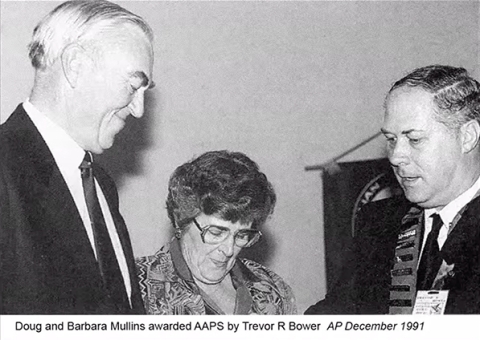
Doug and Barbara Mullins PHOTO: Trevor Bower
ABOUT THE AWARD’S BENEFACTORS: DOUG AND BARBARA MULLINS
In 2009, Barbara Mullins provided the Australian Photographic Society with a bequest in memory of her husband, the late Doug Mullins, President of the Society 1964-1966. This bequest was part of the proceeds from the sale of Mullins Gallery, the former headquarters of the South Australian Photographic Federation of which Doug was Patron.
At that time the bequest was intended to support the regular publication of an APS book of members’ work. In 2011 the first edition of APS Gallery was published. In 2012, the APS celebrated its 50th anniversary and a second book was published. No further books have been created and the balance of the bequest has since grown through interest earned.
Seeking to ensure the long-term future of its new Australian Conceptual Photography Prize introduced in 2019, the Society approached the Mullins family with a proposal that would satisfy the intent of honouring both Doug’s and Barbara’s significant contributions to the APS. There was much synergy in the proposal with the style of Doug’s exhibition photography in the Prize, and in Doug and Barbara’s generous support of the arts and the Art Gallery of SA.
In early December 2019, approval was received to apply the balance of the bequest funds to the Prize. The Society has, therefore, retitled the prize as the Mullins Conceptual Photography prize (MCPP) and it will be a permanent reminder of Barbara and Doug Mullins.
.
.
The coordinators of the MCPP are Brian Rope and Roger Skinner – Thank you for your enthusiasm, energy and hard work to help make the Prize happen.
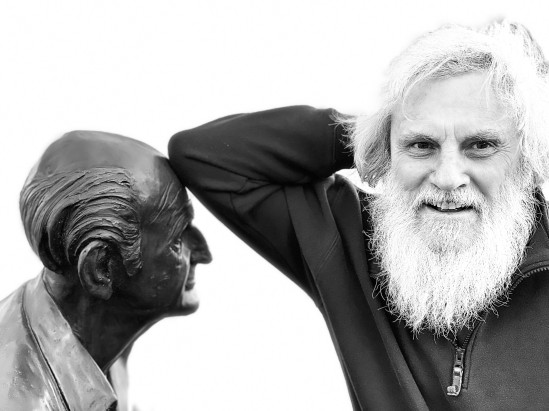
Roger Skinner and Max PHOTO: Doug Spowart
THE MULLINS CONCEPTUAL PHOTOGRAPHY PRIZE gratefully acknowledges all their supporters and sponsors:
• Bengalla Mining Company www.newhopegroup.com.au
• Ilford www.instagram.com/ilfordphoto/
• MACH Energy www.machenergyaustralia.com.au
• Malabar www.malabarresources.com.au
• Australian Photography magazine www.australianphotography.com
Thank you to Eliose Maree and Len Metcalf for their texts. Some texts edited from the APS and MRAC Releases and SM posts
.
©2023 All photos by Doug Spowart
.
.
.
.
.
.
.
.
.
.
NICHOLAS WALTON-HEALEY – SALT FRAMES
.
.
A SELECTION OF IMAGES
.

‘SPOOR’ Nicholas Walton-Healey from the exhibition SALT FRAMES

‘WHISPER’ by Nicholas Walton-Healey from the exhibition SALT FRAMES

‘SKIN’ Nicholas Walton-Healey from the exhibition SALT FRAMES

‘TOUNGE’ Nicholas Walton-Healey from the exhibition SALT FRAMES

‘CARESS’ Nicholas Walton-Healey from the exhibition SALT FRAMES
.
A COMMENTARY ON THE BODY OF WORK by Victoria Cooper
.
watch the water long enough and you’ll see a fish jump … *
.
Salt Frames review
Nicholas is a poet…
Salt Frames is simultaneously a visual and textual poem. On the surface it is an exhibition of light and colour abstractions from time spent on the Nightcliff Foreshore, Darwin. But this work also has deeper layers and meaning that are evoked through the supporting words and symbols within the images, as Walton-Healey discloses: “Sea salt aids the healing of wounds (including those beneath the surface of the skin).”
Walton-Healey points out that more broadly Australians have an affinity to the coast. The sea and the coast become places of personal meditation and for some physical and psychological healing. His seascapes are not the usual pictorial or grand panorama – instead he shares visual metaphors; those moments of revelation and contemplation that can hold many different meanings to the viewer.
The text blocks with the images are, for me, not titles but words that operate as codes to other ways of being and thinking. If we cast our minds to memories of reverie by the sea, perhaps these words articulate our collective human experience of being at the coast.
On connecting with Walton-Healey’s opening speech, the meaning embedded in the words and the images of layered light, colour and stilled moments was underpinned by a deeply moving human story. Through the visual poetry of this exhibition the artist has humbly shared vulnerability, tenderness and deep thinking. In this openness of vision he also created space for the viewer to spend time to consider and connect with our own stories and memories.
.
Dr Victoria Cooper
* A teaching by Larrakia Warrior Robert E. Lewis to Nicholas Walton-Healey
.
.
THE OPENING SPEECH BY PAMELA KLEEMANN-PASSI

Pamela Kleeman-Passi speaks
.
Acknowledgement to Country
We respectfully acknowledge the Traditional Owners of the land, the Boon Wurrung and Woiwurrung (Wurundjeri) peoples of the Kulin Nation. We extend gratitude to all Elders past and present and their enduring connection to land, sea and community.
.
.
Welcome to the Salt Frames exhibition …
.
My friendship with Nick grew out of a deeply personal connection of loss and renewal, and a mutual passion for experiencing life through the lens of creativity. And now we have Darwin in common! Our shared stories meandered and overlapped during my month there mid-last year for my own exhibition. I actually didn’t know that much about Darwin until that visit, and I returned to Melbourne with a deep fondness for the culture, the landscape and the communities. I thank Nick for facilitating a visit to the Tiwi Islands to spend a moment of precious, rejuvenating time at the Tarntipi Bush Camp on Bathurst Island.
.
So what you see within these salt frames of the Nightcliff foreshore is Nick’s immersion in and introspection on the blessings and cruelties of life, and the healing power of the water and the land. The evocative single word titles express an array of feelings and experiences and the images are imbued with opposites:
Landscape / seascape Water / land Surface / depth
Smoothness / crusty, gritty textures Clarity / blurriness Light / dark
Shadows / highlights Colour / monochrome Reflection / absorption
Representation / abstraction Emotion / rationale
He’s combined the poetic and the photographic, with an Impressionist painterly quality to many of the works. Nightcliff is a very special place for Nick… but it also has a fascinating history and I quote from Tess Lea’s personal/historical book, Darwin: “Even the dumping grounds of Nightcliff, where unwanted machinery and detritus from WWII were tipped over a cliff, have merged into the rocks below, no longer distinguishable, just deformed lumps of rust and chalk.” The colour of rusted metal is very evident within some of the images – how over time, it’s merged with the landscape shaped by the power of the sea.
In this time of climate fragility and significant settler land and sea degradation, I feel compelled to refer to ecological grief and the healing power of the land and the water because the land and sea are absolutely fundamental to a community’s overall mental health. Nick’s images are testament to that healing power.
For Nick…
On the edge, at the edge… of love and loss and longing,
And remembering and wanting to forget
And letting go but holding on…
Wedged between land and water, pushing and pulling
Lapping across a surface that belies a depth so utterly profound and unfathomable
A photographic imprint, focused and blurred
Where light inscribes water, water inscribes land
And language and form mutate and merge, rippling and surging in a constant soundtrack
That violently crashes and gently caresses in waves and heartbeats
Eroding, erasing, healing and repairing
The run-off leaving traces that ebb and flow
As life and love and loss and longing ebb and flow…
And it’s sink or swim or scramble to a fragile stability on solid ground and remain upright
or undone
Or both…
.
.
Pamela Kleemann-Passi © 2023
.
.
ROBERT LEWIS TALKS ABOUT HIS CONNECTION WITH NICK

Robert Lewis, Larrakia Warrior, speaks at the opening of SALT FRAMES
.
Nic from Vic
Hi my name is Robbie Lewis, I’m a Larrakia Man. Born and bred on Larrakia land in Darwin.
2013, The Eye See Workshop, working with young Indigenous people living on a local community, in the Darwin region, where I met a young man trying to make understanding of life, this is when I first met a young spirited man, Nicholas Walton-Healey!!
.
A student photographer trying to find he’s way around the community. At first, I saw another white man taking photos of Indigenous people. But now, 10 years later, I see a great man showing the rest of the world through he’s eyes the beautiful things he sees through a camera.
To talk about
Communications – to talk, to say, to hear, to listen, to answer, to reply, also to understand and help.
Management – to be a leader, a teacher, to educate, to be in charge, to manage and help.
Worker – to do a job, to earn a wage, to keep things moving forward, to do work and to help where there is no other.
Just don’t forget why they go together.
The Student
This one person brings all these people together.
Now I see this man as a teacher!!
.
Robert Lewis © 2023
.
.
NICK’S RESPONSE

Nick addresses the audience at his exhibition
.
Thank you everyone for making it out tonight. I don’t have the time to personally thank each one of you, here. But I’m really proud of, and humbled by, the diversity of the groups represented in this room. Friends. Family. Collaborators. Colleges. Mentors. And Muses. You’ve all contributed in some important way to the journey I’ve been on, with my photography.
Pam and Rob, I’m especially grateful for the friendship I share with each of you, and for your very kind and thoughtful words tonight.
.
What you’re looking-at in the salt frames photographs, is The Timor Sea. And more people go missing each year in The Timor Sea, than they do in any other sea throughout the world.
I can certainly say that I’ve felt the pull. The allure of its rhythm, and hypnotic calamity.
It made perfect sense to me, when I read that statement in a book that Pam recently lent to me. Over the past twelve months, Pam has gifted me some important inspiration – we met at the ANAT Spectra Live event in Melbourne, and our paths crossed again in The Northern Territory last year. They converged at Tactile Arts in Darwin, during Sweet Dreams and Gut Reactions, the title of Pam’s exhibition, which got me thinking…
It’s probably an understatement, for those of you who know me, to say I’m inspired by the viscerality of art. I’ve always understood the role of the artist to entail a questioning of accepted definitions of the normal and possible. And that the moral and aesthetic responsibility of the photographer is to make the invisible, visible and the familiar, strange…
Photography is a highly intuitive process for me. I make the pictures first, and make-sense of them, second. So, I wasn’t exactly sure what I was doing, walking up and down the Nightcliff foreshore at all hours of day and night, last year.
I was actually stopped one evening by an elderly couple, who said ‘ahh, you’re a photographer!?’ I looked-at them, bemused, because I had a camera in my hand, and responded with, ‘yeah!’ But then the lady then came closer, and touched me on the arm. She looked into my eyes and said, ‘Well, that’s good, because we’ve seen you out here every night this week and thought you were homeless.’
The remark startled me because, while I was always on the lookout for crocs, I actually felt pretty safe in Darwin last year, which was when I made the majority of these photographs. Even if I was sleeping on a mattress on the floor of Rob’s kitchen.
I have a really special connection with Rob, who is like a big brother, to me; one of my mentors, teachers, guides and best mates, over the past ten years.
I first met Rob on an Indigenous community known and referred to in Darwin as Knuckey’s. This was back in 2013, when I first travelled-up to Darwin with one of my university lectures – Mark Galer – for The Eye See Workshop. Although our initial encounters were brief, I remember being struck by the enormity of Rob’s heart; the fact that he actually, genuinely cared for the people living on this, and the other communities we visited.
At the end of that workshop, I was invited back to Darwin by Rob’s boss-at-the-time. From this point, I entered into what became a five-year-plus partnership. This lead me back out onto those communities, and ultimately, to almost all of the so-called town camps in and around the Greater Darwin Region.
For all this time, I was like Rob’s little shadow. I followed him everywhere, and especially to the programs he ran with the men and family groups from these communities. Through these means, I built my own friendships and connections. But that’s another story, another project…
The Salt Frames are more overly focussed on my personal connection with Rob. Our friendship grew partly through the bond I developed with his late mother, Robyn, who I learnt to recognise and identify as an authentically Darwin person; Robyn’s mother (Rob’s maternal grandmother), was born at Lamaroo Beach, before being stolen as a child, and was eventually adopted by Juma Fejo.
The Fejos are one of the original eight family groups recognised as the Traditional Custodians of the Greater Darwin Region.
So Rob’s Larrakia, and the Larrakia are also known as The Salt Water People. The Salt Frames show Larrakia country, which includes Nightcliff, the place where Rob and I spent a lot our time when we weren’t working on the communities together.
Watch the water long enough and you’ll see a fish jump. That’s what Rob used to say to me. And I found it really frustrating at first, because I couldn’t see any fish. But over time, I realised that, rather than asking me to simply look-at the water, Rob was actually asking me to look into it. In this way, he transformed my ability to ‘see.’
But he wasn’t the only person I went to Nightcliff beach with. Before and after re-locating from Melbourne to Darwin, Nightcliff was the place that my late fiancé most liked to visit. She loved watching the sunsets. And unwinding and connecting on the beach. Over the years, we made a lot of love along this coastline. Beside the Timor Sea. And sure enough, it was not too far up from one of these spots that we returned on the afternoon she received her cancer diagnosis.
Shit happens. We deal with it. And then we move-on. That’s also one of Rob’s sayings; but it was the teaching I found most difficult to comprehend. Dealing with it, was what I really trying to do in the five and half months I spent in The Territory last year, walking around the beach like a homeless person.
Making these photographs was one way I felt I could make-good on my promise to do something with my photography, while at the same-time maintaining the connection that my finance and I shared with the families and communities we worked with. In August last year, Rob accompanied my mother and I over to the Tiwi Islands, for her Pukamani ceremony. The overwhelming majority of the photographs in this collection were made in the weeks that followed this event.
So whichever way you look at them, the Salt Frames show profound and enduring connection. But they also acknowledge the inescapably transient nature of being. You don’t get to beauty without pain, and love is very hard to name, without seeing the full-face of loss. The process of curating and assembling this show, and gathering you all in this room tonight, is part of an attempt to move forward.
..
Thank you all … Nicholas Walton-Healey
Nicholas Walton-Healey © 2023
.
.

Nicholas with Pam Kleemann-Passi and Robert Lewis
.
.
.
.
.
.


























